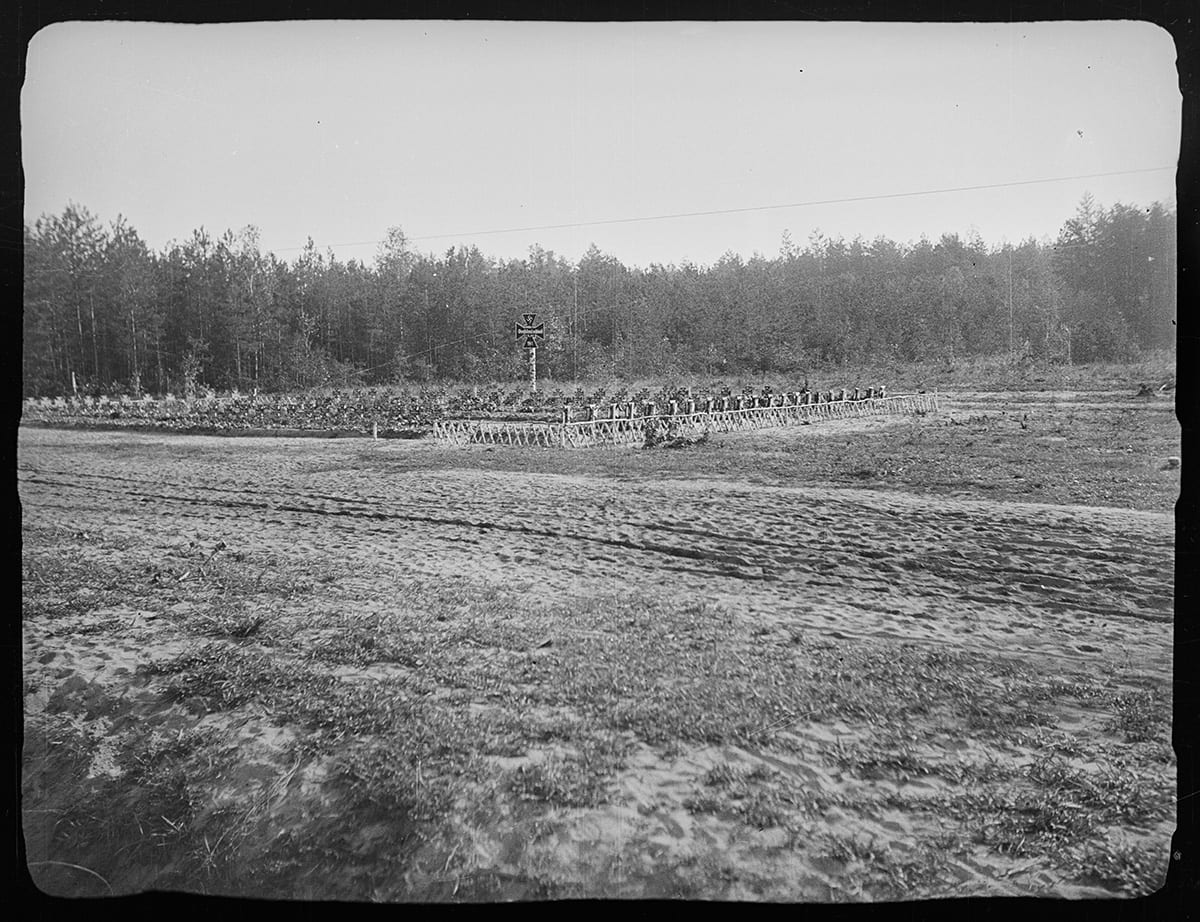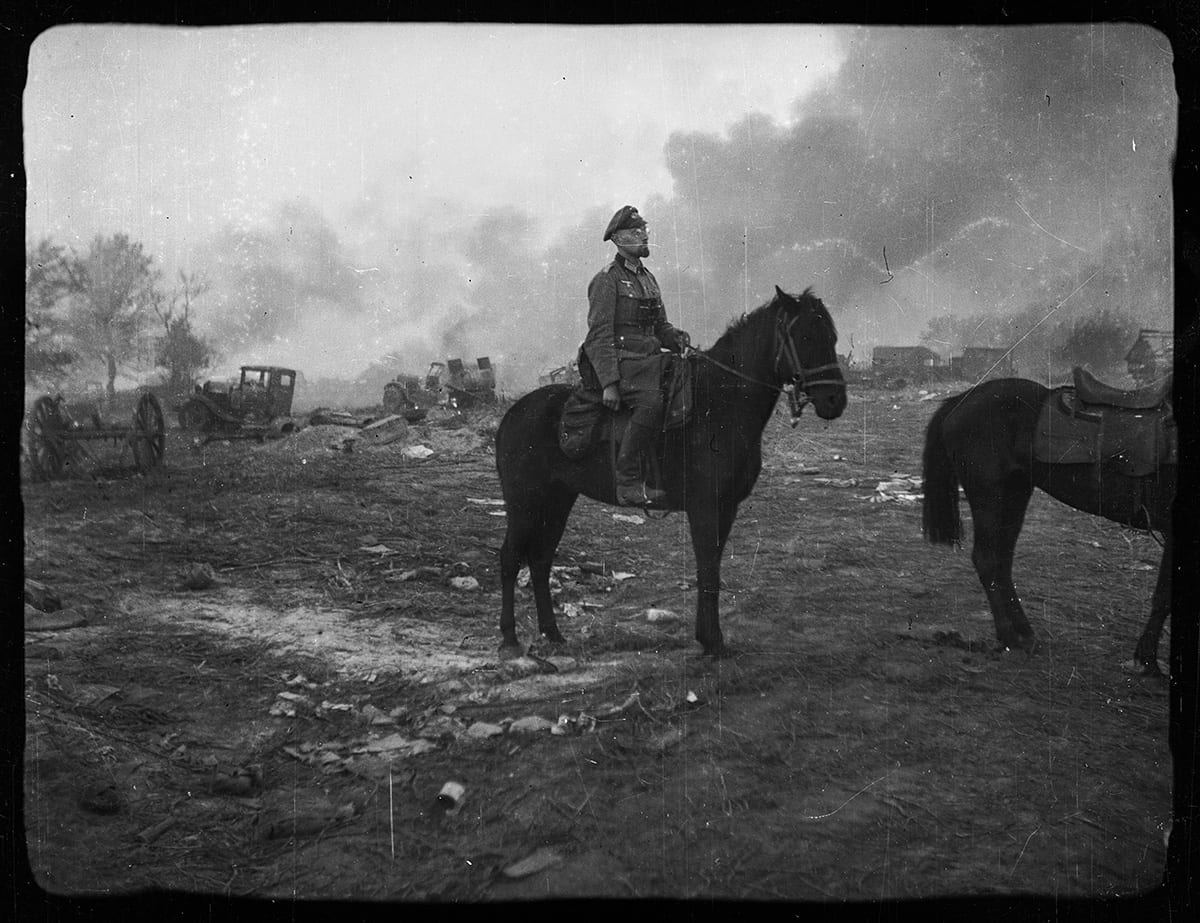
Invasion of the USSR: Battle of Kiev 1941
Operation «Barbarossa» on the invasion of Germany into the Soviet Union, which began on June 22, 1941, involved three groups of armies, which combined at least 120 divisions. It was the most powerful concentration of Wehrmacht forces in World War II. The combat mission of Group South was the destruction of the Red Army on the territory of Ukraine west of the Dnieper. The spearhead of this group was Kleist’s 1st Panzer Group, named after its commander, General von Kleist. It consisted of five Panzer, three Motorized, and four Infantry divisions, later joined by Hungarian, Italian, and Slovakian contingents.
This previously unknown archive of an unknown German officer is a unique documentary evidence of the beginning of the German Army’s Blitzkrieg against the USSR. Several rolls of black-and-white film were packed in special cardboard canisters, some of which were signed «Eastern Front» (German: Ostfeldzug) with a pencil by the photographer.
At the beginning of the war the photographer was at the location of the 298th Infantry Division of the Wehrmacht. At the end of June 1941 the soldiers of the 298th Infantry Regiment entered the battle for the first time on the Eastern Front. The insignia of the 298th Infantry Division was a deer skull with horns and the letter G between the horns. The division commander was Lieutenant General Walther Graeßner. During the invasion of Ukraine the division was part of the XVII Army Corps, 6th Army (which would later be defeated at Stalingrad).
All the photographs were captured during the first few months, August — September 1941, when German troops had already occupied half of the territory of Ukraine and were approaching Kiev. One of the most interesting and rare shots are those taken presumably during the so-called «Kiev pocket», which was the largest defeat of the Red Army during the Great Patriotic War. German generals called it «the greatest encirclement battle of World War II» and their "biggest victory. In the Kiev pocket of 1941 the entire Southwestern Front of the Red Army was defeated and captured: four Soviet armies were defeated and destroyed completely, two more were partially defeated.
According to German reports, the Red Army lost 665,000 prisoners of war. This is the largest number of prisoners captured in a single battle. According to the data published in 1993 by the general headquarter of the Russian Armed Forces, the Soviet losses exceeded 700 thousands of people, of which 627.8 thousands were irretrievable. The defeat of the Southwestern Front opened the way for the enemy to the Eastern Ukraine, the Azov Sea region, and the Donbass.
The photographs taken by this unknown German photographer show various moments of life and death during the war. Judging by the composition of the shots, the framing, the photographer’s own shadow in the frame, and the periodic overlapping of shots as the film was improperly stretched in the camera, the photographer was more of an amateur. In his pictures you can see the rapid advance of German troops on the territory of Ukraine, despite the lack of roads, repair of bridges blown up by the Red Army, resting of German soldiers, eating and vaccination. But of course what is most striking are the images of the horror and scale of the aftermath of the fighting between the German and Soviet armies on the battlefields: the still smoking remains of crushed Soviet equipment, the abandoned horses walking in shock, the dead and captured Red Army soldiers. All these pictures strongly convey the atmosphere of the beginning of the war, a war that would last another 4 years and end in the defeat of Nazi Germany.

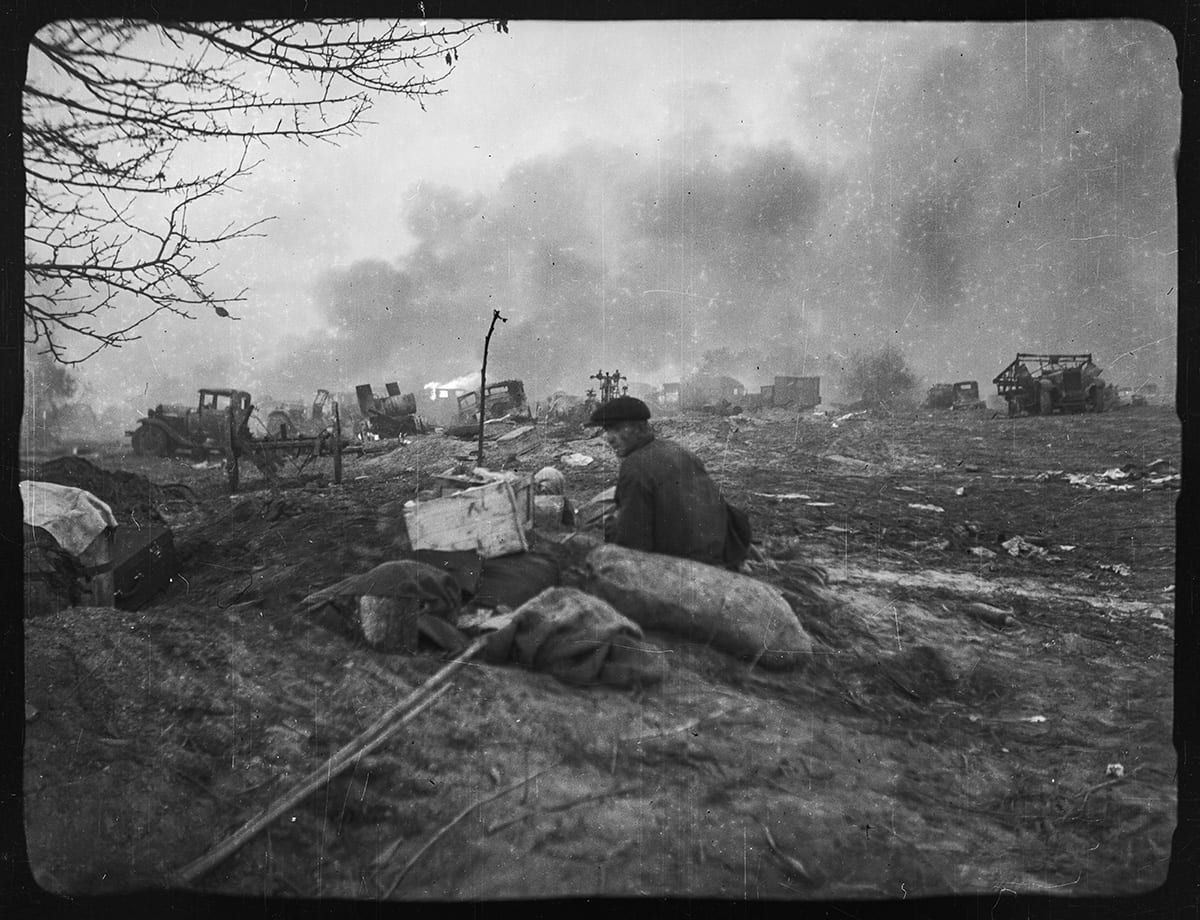
After the battle. GAZ-AA Polutorka, ZIS-5 trucks and GAZ-61 all-wheel drive cars can be seen among the wrecked Soviet vehicles. Presumably the Kiev cauldron, Ukraine. August - September 1941
After the battle. GAZ-AA Polutorka, ZIS-5 trucks and GAZ-61 all-wheel drive cars can be seen among the wrecked Soviet vehicles. Presumably the Kiev cauldron, Ukraine. August - September 1941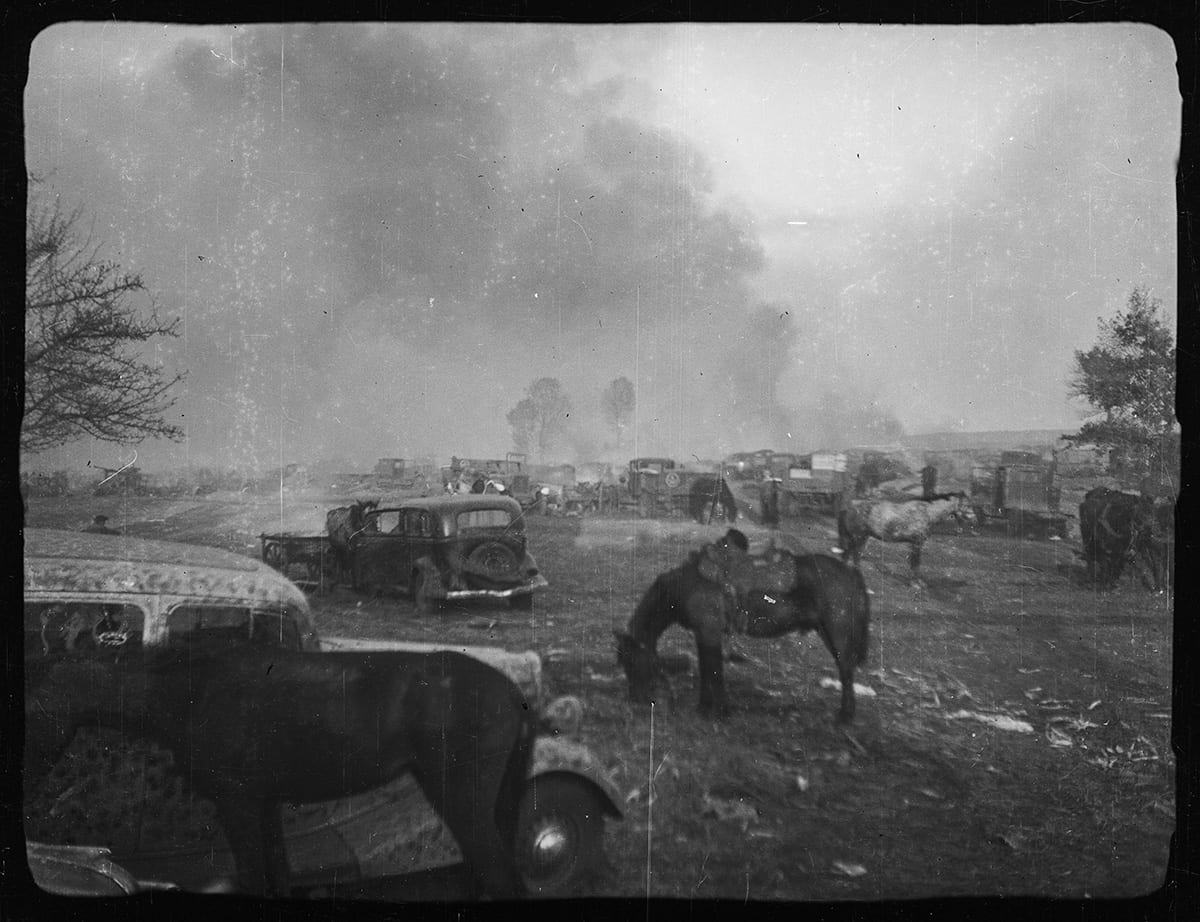
The surviving horses wander amidst the still smoking remains of Soviet vehicles: GAZ-AA Polutorka trucks, ZIS-5, and GAZ-61 all-wheel drive cars. Presumably the Kiev cauldron, Ukraine. August - September 1941
The surviving horses wander amidst the still smoking remains of Soviet vehicles: GAZ-AA Polutorka trucks, ZIS-5, and GAZ-61 all-wheel drive cars. Presumably the Kiev cauldron, Ukraine. August - September 1941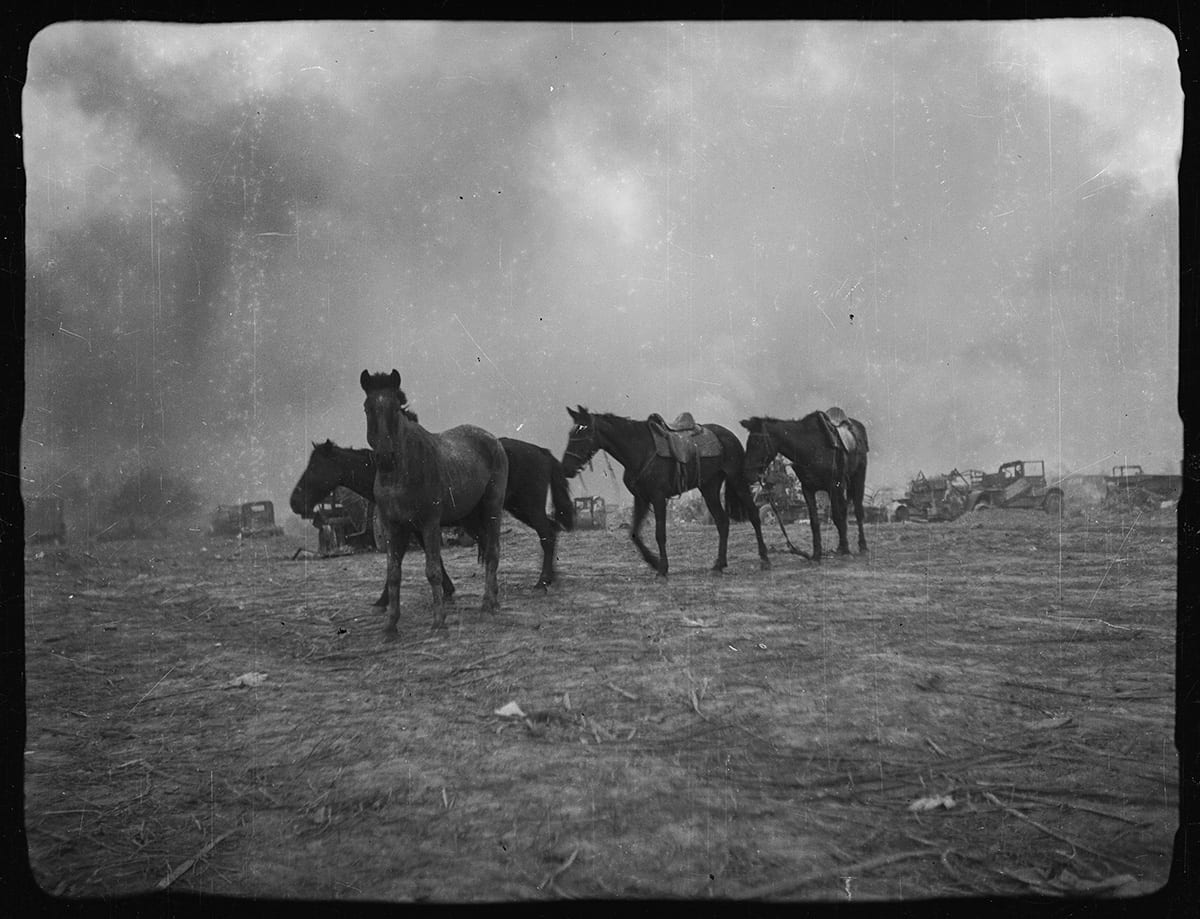
The surviving horses wander in the middle of the still smoking remains of Soviet equipment. Presumably the Kiev cauldron, Ukraine. August - September 1941
The surviving horses wander in the middle of the still smoking remains of Soviet equipment. Presumably the Kiev cauldron, Ukraine. August - September 1941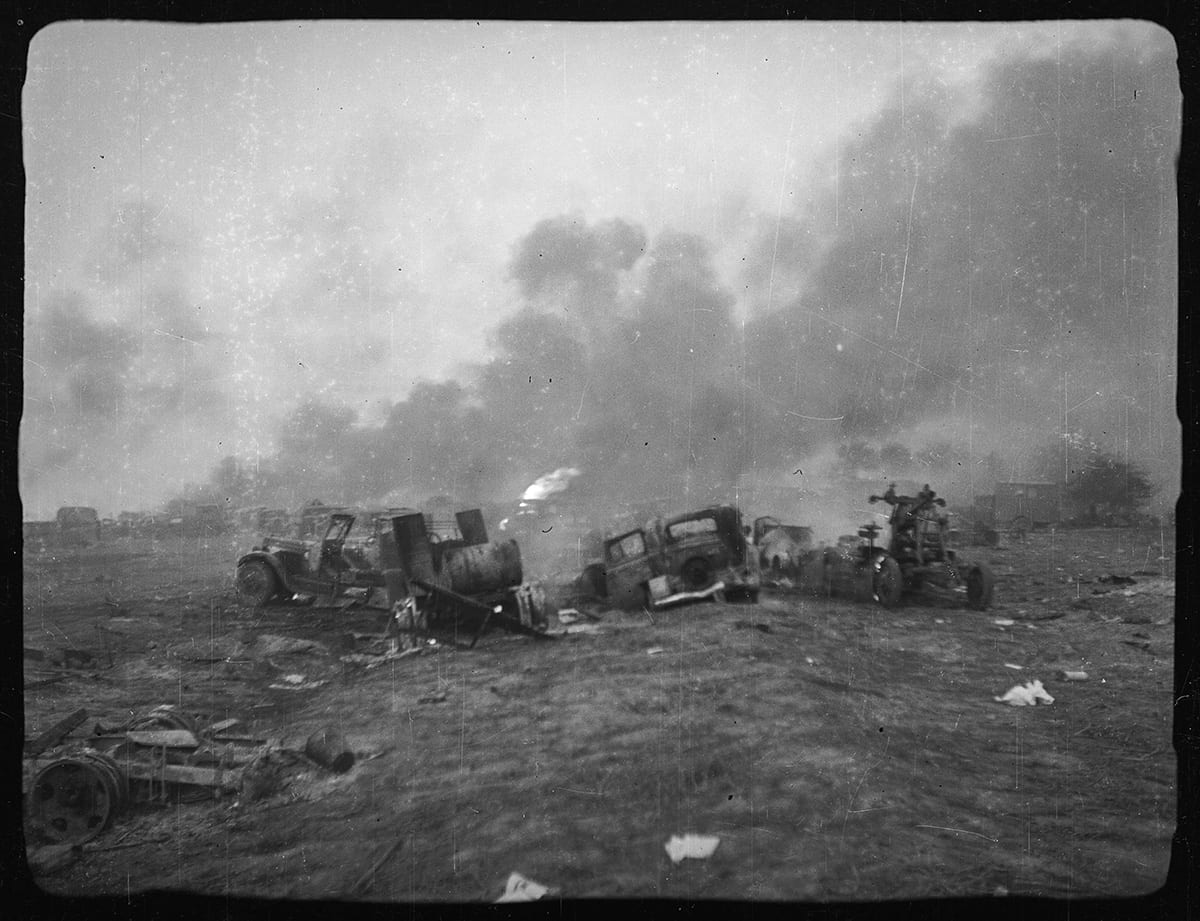
The burning and smoking remains of Soviet equipment: GAZ-AA Polutorka trucks, GAZ-61 four-wheel drive car and a wheel base of an anti-aircraft gun. Presumably the Kiev cauldron, Ukraine. August - September 1941
The burning and smoking remains of Soviet equipment: GAZ-AA Polutorka trucks, GAZ-61 four-wheel drive car and a wheel base of an anti-aircraft gun. Presumably the Kiev cauldron, Ukraine. August - September 1941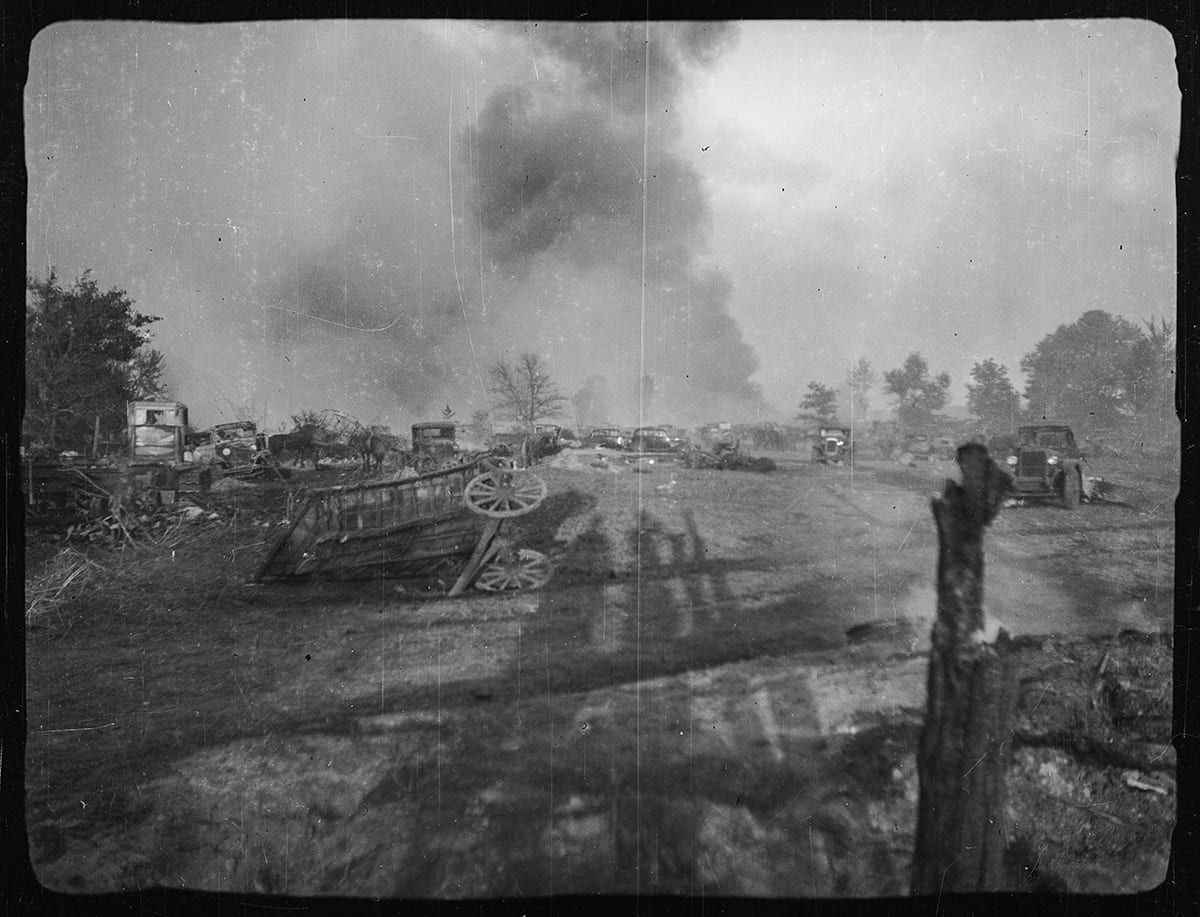
The burning and smoking remains of Soviet military equipment: GAZ-AA Polutorka trucks and GAZ-61 all-wheel drive cars. Presumably the Kiev cauldron, Ukraine. August - September 1941
The burning and smoking remains of Soviet military equipment: GAZ-AA Polutorka trucks and GAZ-61 all-wheel drive cars. Presumably the Kiev cauldron, Ukraine. August - September 1941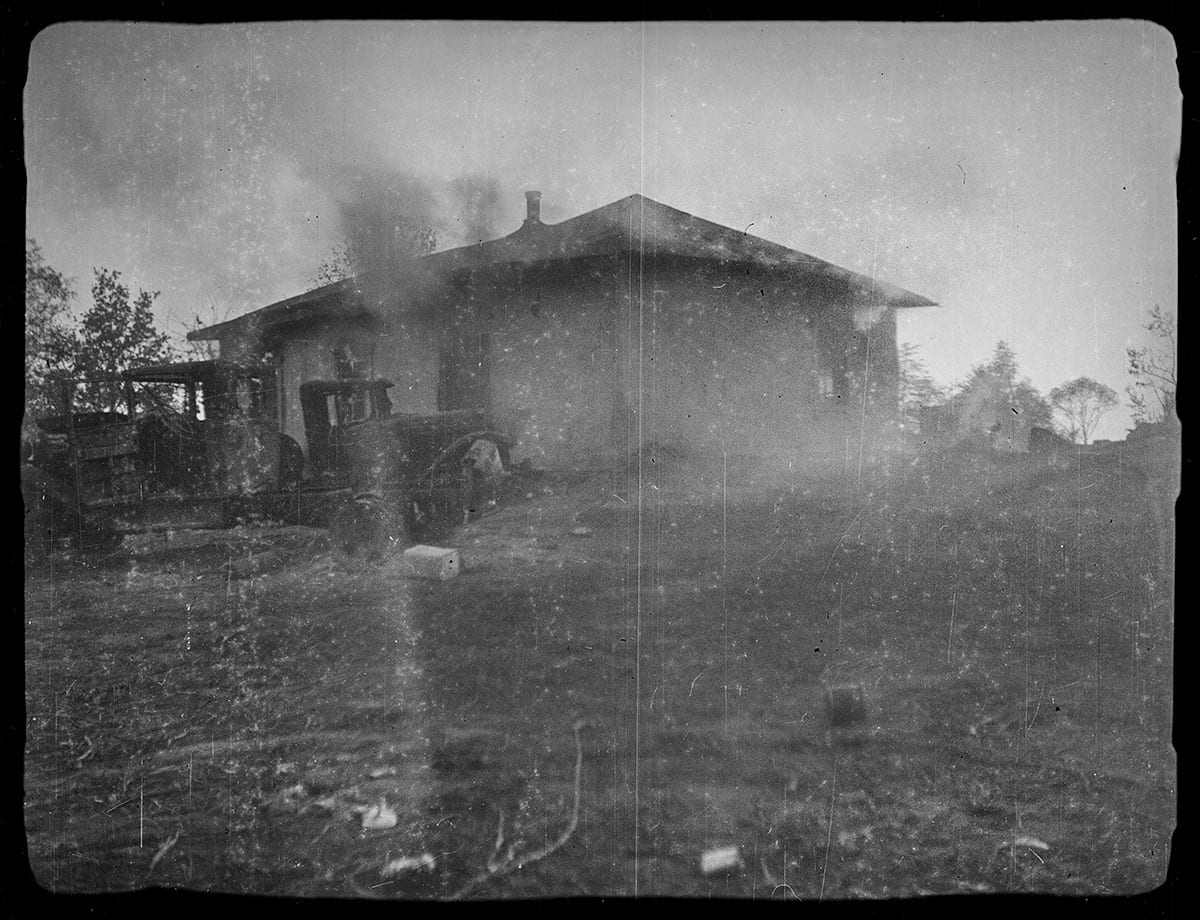
The remains of broken Soviet GAZ-AA Polutorka trucks near a burning village house. Presumably the Kiev cauldron, Ukraine. August - September 1941
The remains of broken Soviet GAZ-AA Polutorka trucks near a burning village house. Presumably the Kiev cauldron, Ukraine. August - September 1941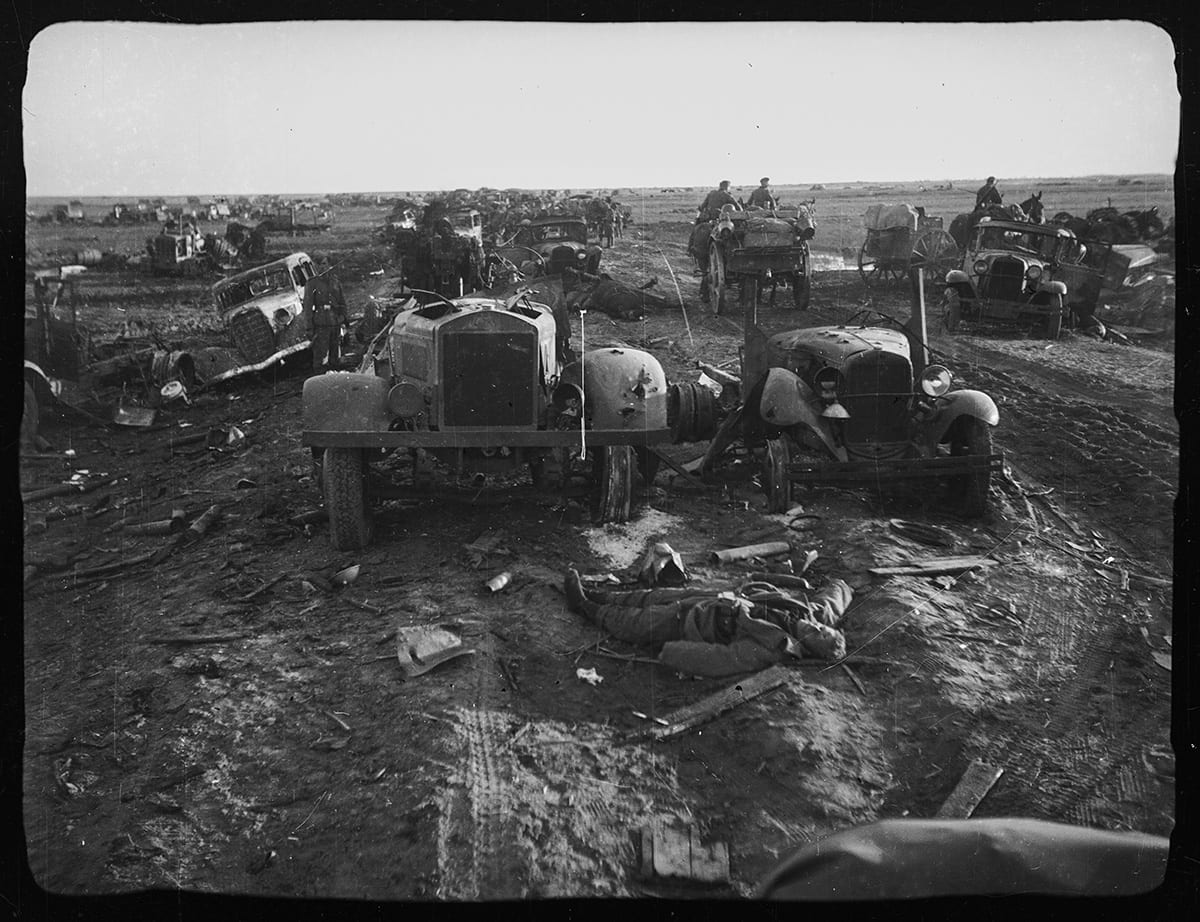
Wrecked Soviet equipment and dead soldiers on the battlefield. Among the vehicles seen are GAZ-AA "Polutorka" trucks, GAZ-33, GAZ-61 all-wheel drive cars, and the Stalinets-65 (C-65) tractor used as a tractor at the time. Presumably the Kiev cauldron, Ukraine. August - September 1941
Wrecked Soviet equipment and dead soldiers on the battlefield. Among the vehicles seen are GAZ-AA "Polutorka" trucks, GAZ-33, GAZ-61 all-wheel drive cars, and the Stalinets-65 (C-65) tractor used as a tractor at the time. Presumably the Kiev cauldron, Ukraine. August - September 1941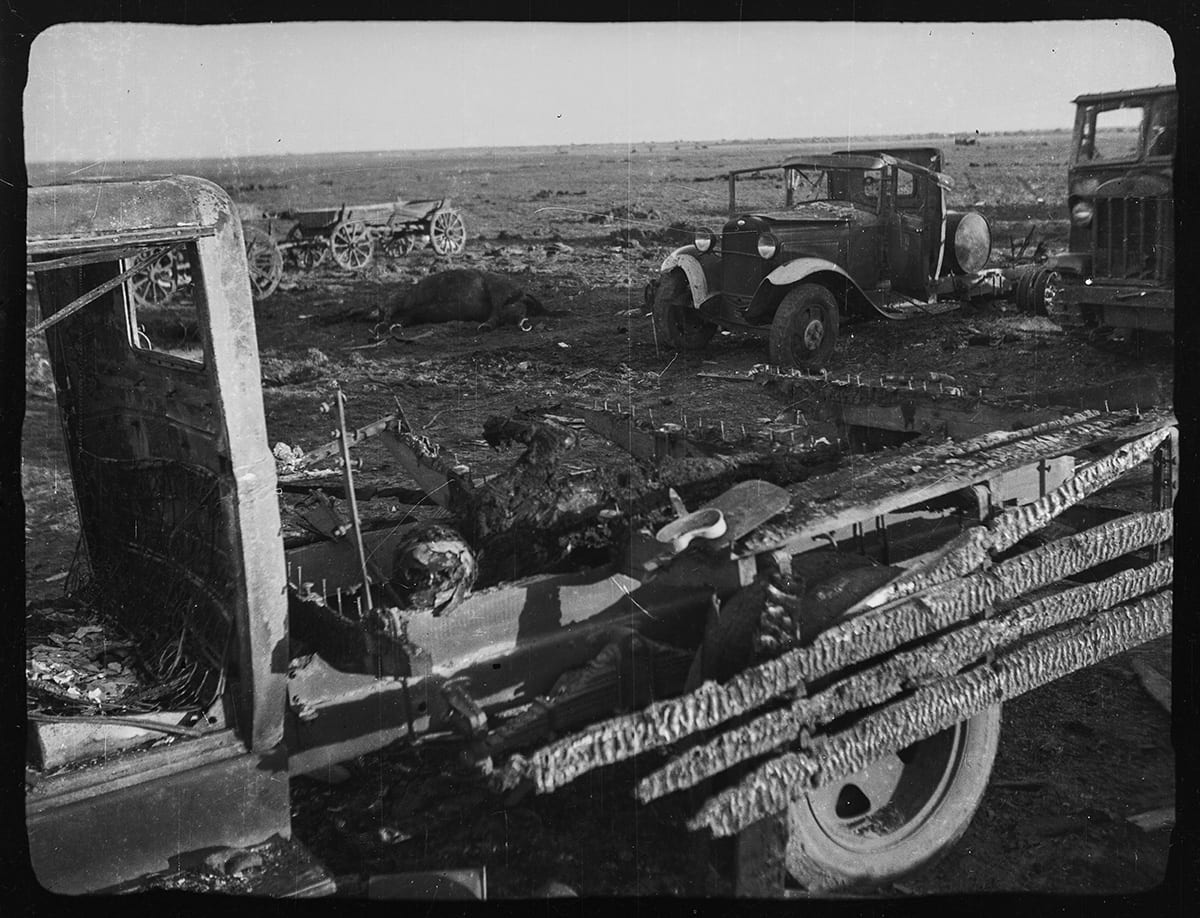
Soviet burnt-out equipment after a battle. In the foreground, the charred body of a Red Army soldier lies in the body of a burned GAZ-AA Polutorka truck. A burnt-out caterpillar tractor STZ-5-NATI is seen in the background on the right. Presumably the Kiev cauldron, Ukraine. August - September 1941
Soviet burnt-out equipment after a battle. In the foreground, the charred body of a Red Army soldier lies in the body of a burned GAZ-AA Polutorka truck. A burnt-out caterpillar tractor STZ-5-NATI is seen in the background on the right. Presumably the Kiev cauldron, Ukraine. August - September 1941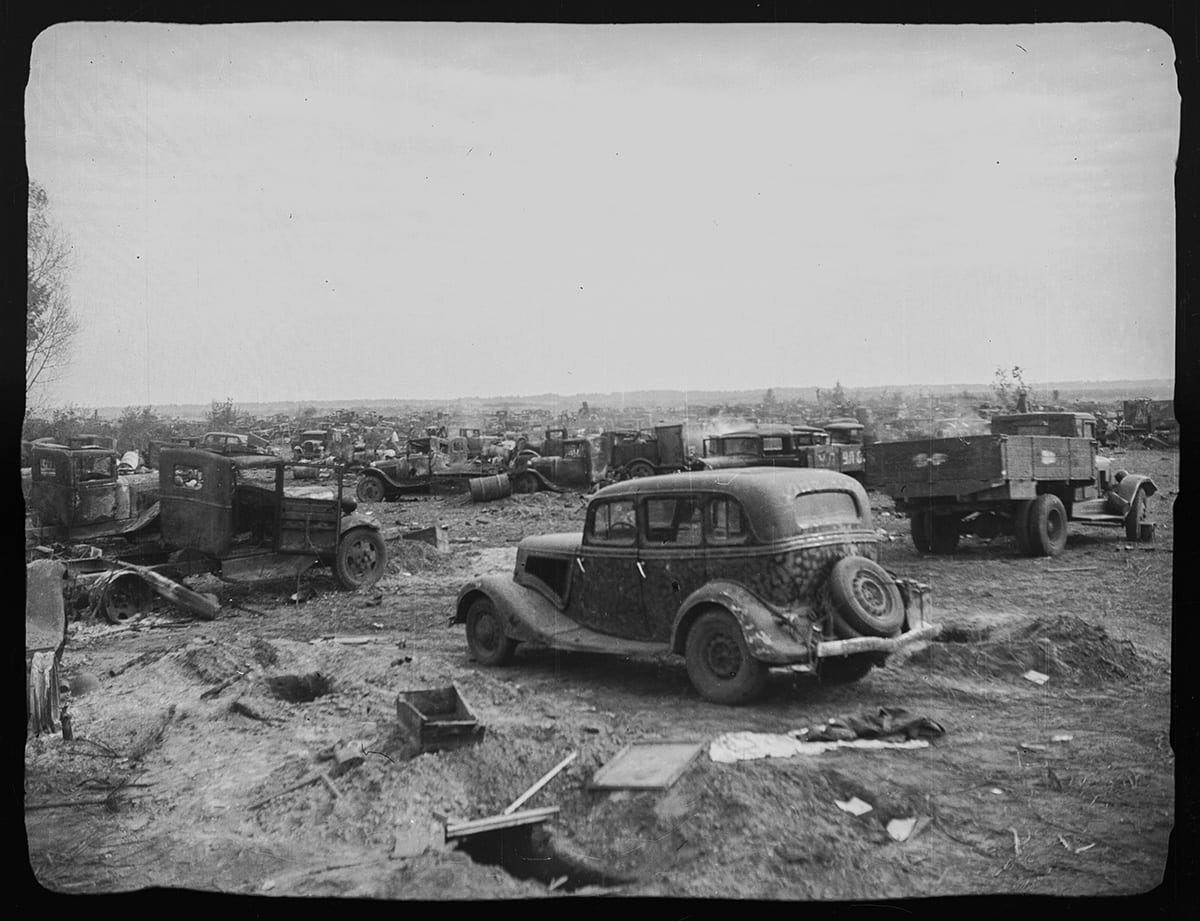
Panorama of wrecked Soviet vehicles: GAZ-AA Polutorka trucks and GAZ-61 all-wheel drive cars. Presumably the Kiev cauldron, Ukraine. August - September 1941
Panorama of wrecked Soviet vehicles: GAZ-AA Polutorka trucks and GAZ-61 all-wheel drive cars. Presumably the Kiev cauldron, Ukraine. August - September 1941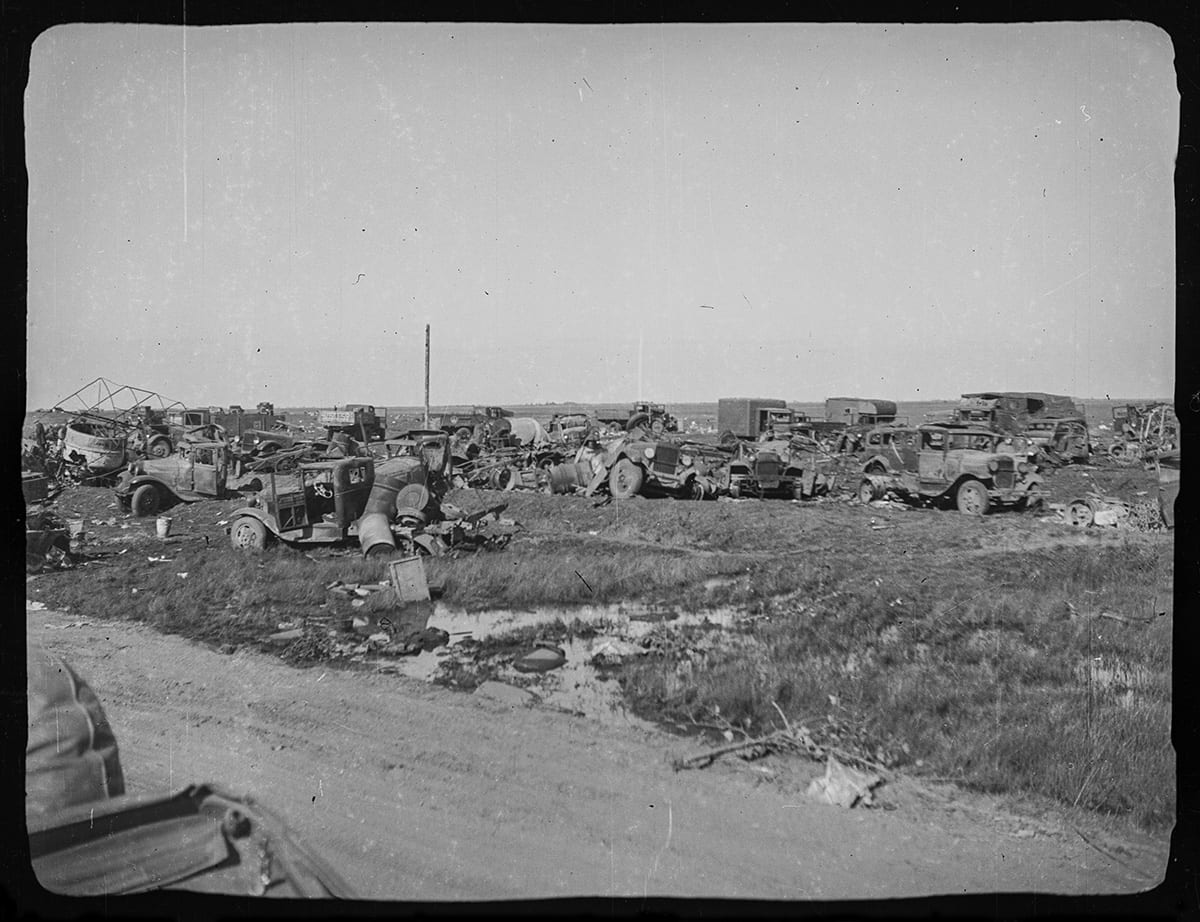
Wrecked Soviet equipment. Presumably the Kiev cauldron, Ukraine. August - September 1941
Wrecked Soviet equipment. Presumably the Kiev cauldron, Ukraine. August - September 1941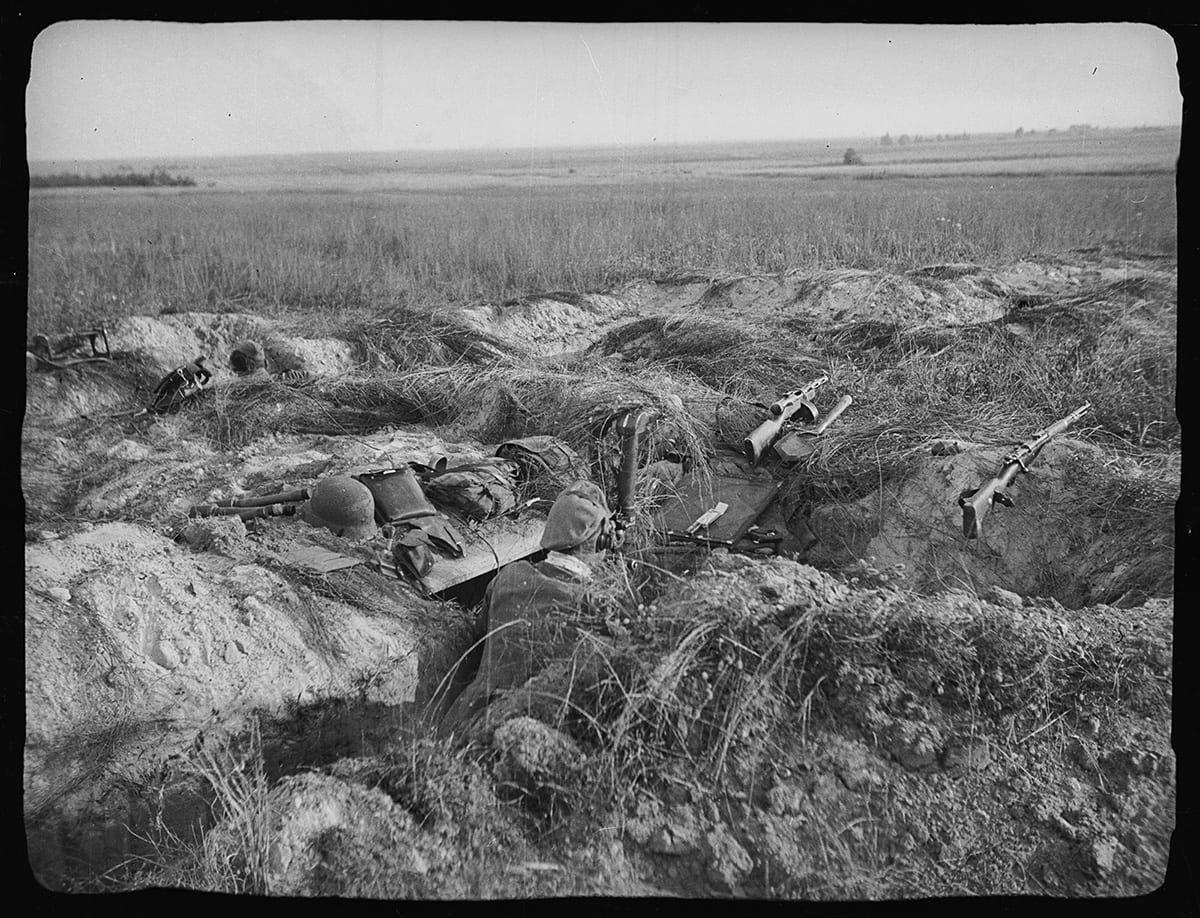
A German officer at an observation post looking behind the front edge into an army rangefinder. A Soviet Degtyarev submachine gun PPD-40, a German Mauser rifle, and German Stielhandgranate M-24 "Kolotushka" hand grenades lie on the edge of the trench. Ukraine. August-September 1941
A German officer at an observation post looking behind the front edge into an army rangefinder. A Soviet Degtyarev submachine gun PPD-40, a German Mauser rifle, and German Stielhandgranate M-24 "Kolotushka" hand grenades lie on the edge of the trench. Ukraine. August-September 1941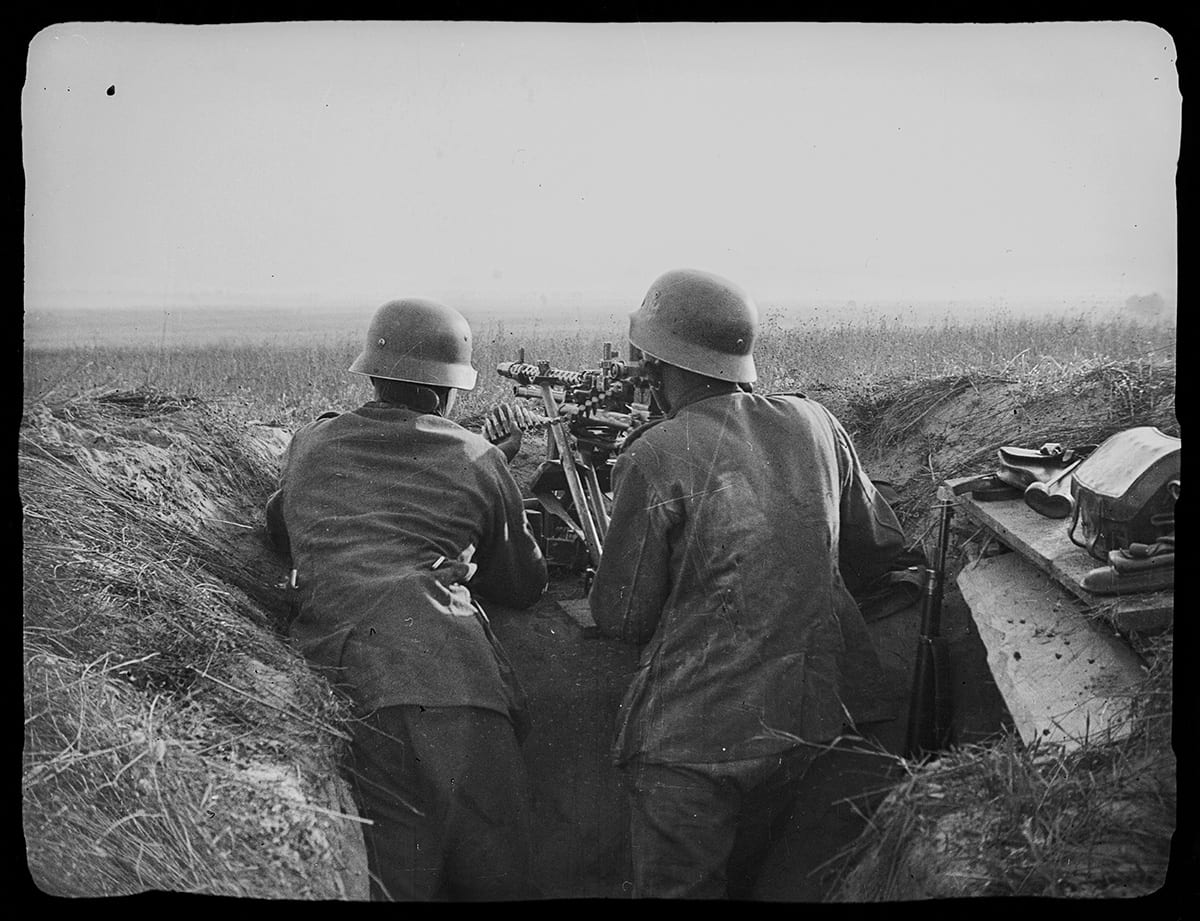
German machine gun MG-34 with the crew during the battle. Ukraine. August - September 1941
German machine gun MG-34 with the crew during the battle. Ukraine. August - September 1941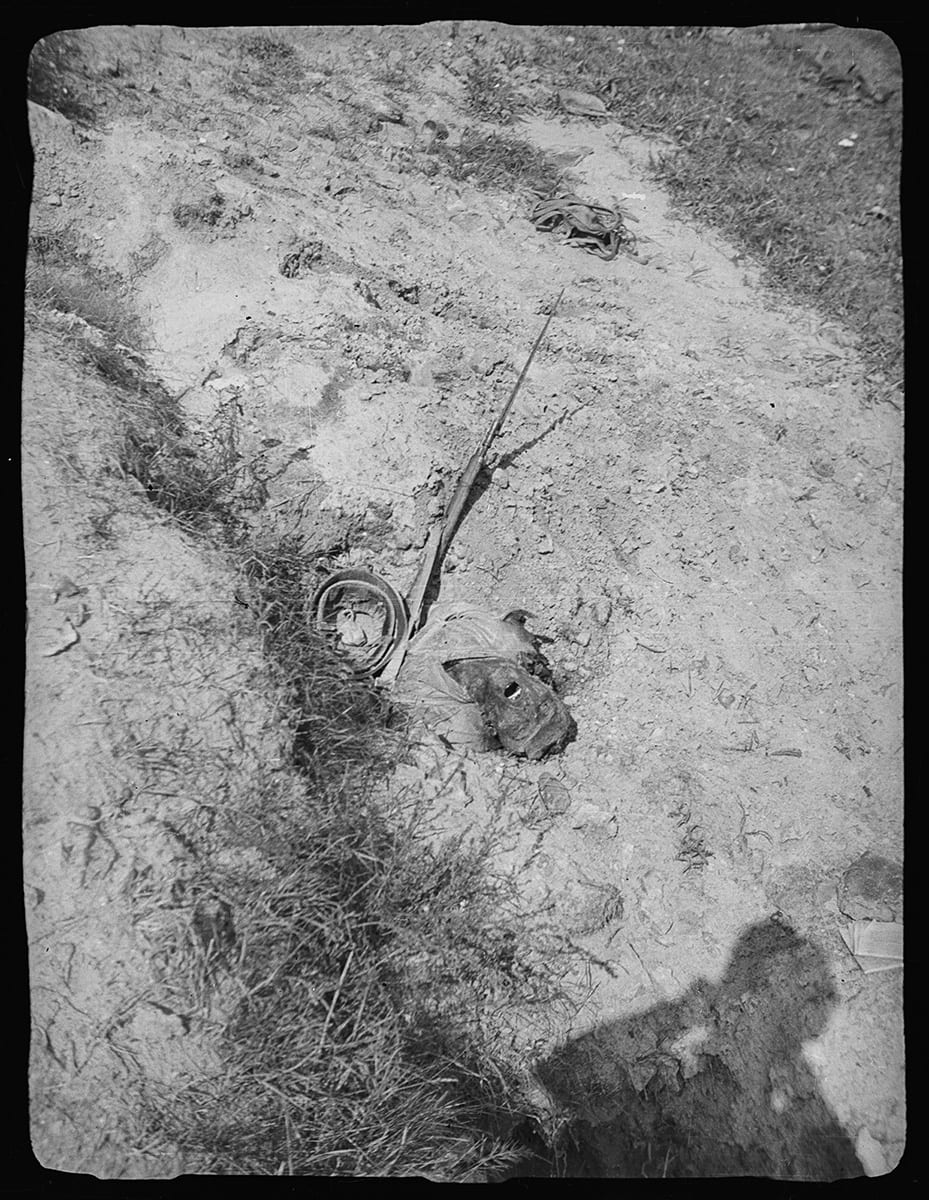
The body of a Red Army soldier killed in action with a Mosin rifle and bayonet strapped on. August - September Ukraine. 1941
The body of a Red Army soldier killed in action with a Mosin rifle and bayonet strapped on. August - September Ukraine. 1941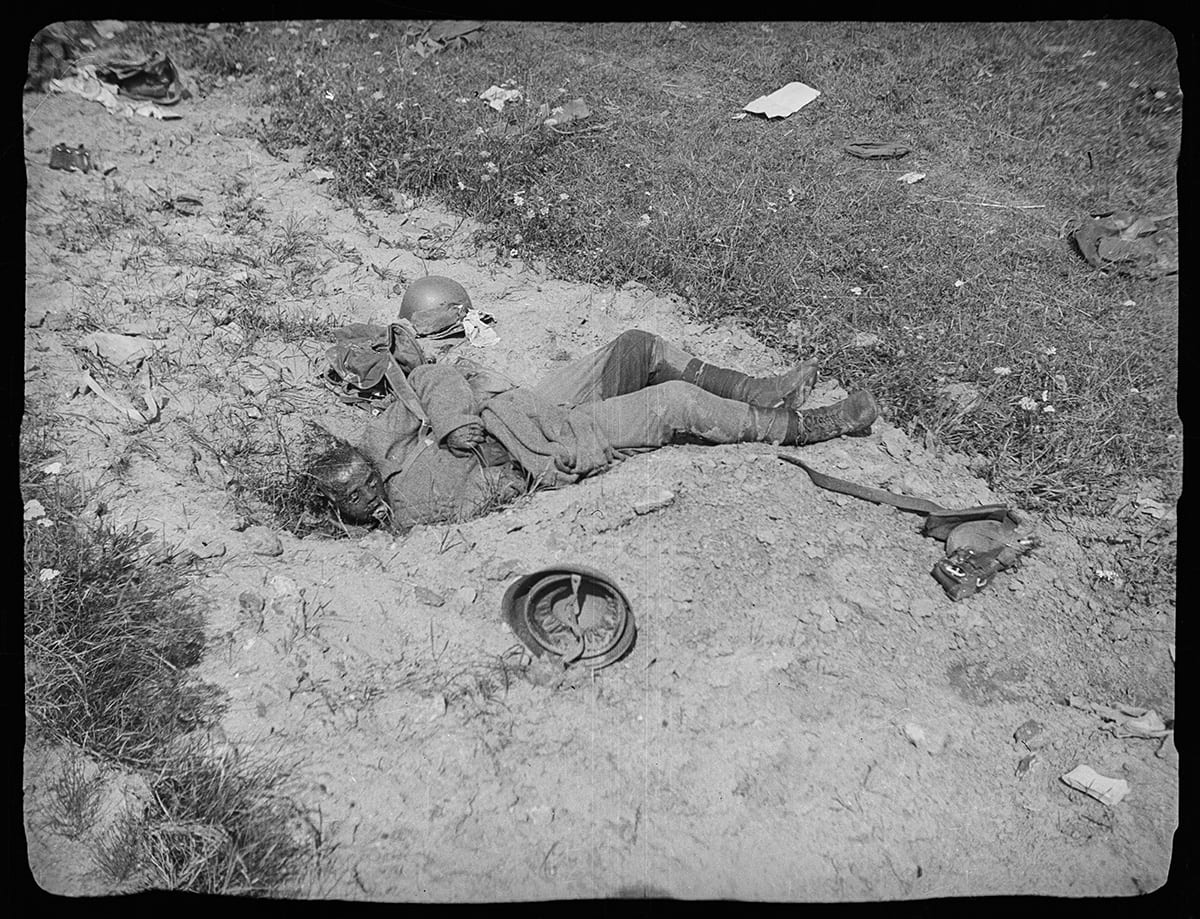
The body of a Red Army soldier killed in battle. August - September Ukraine. 1941
The body of a Red Army soldier killed in battle. August - September Ukraine. 1941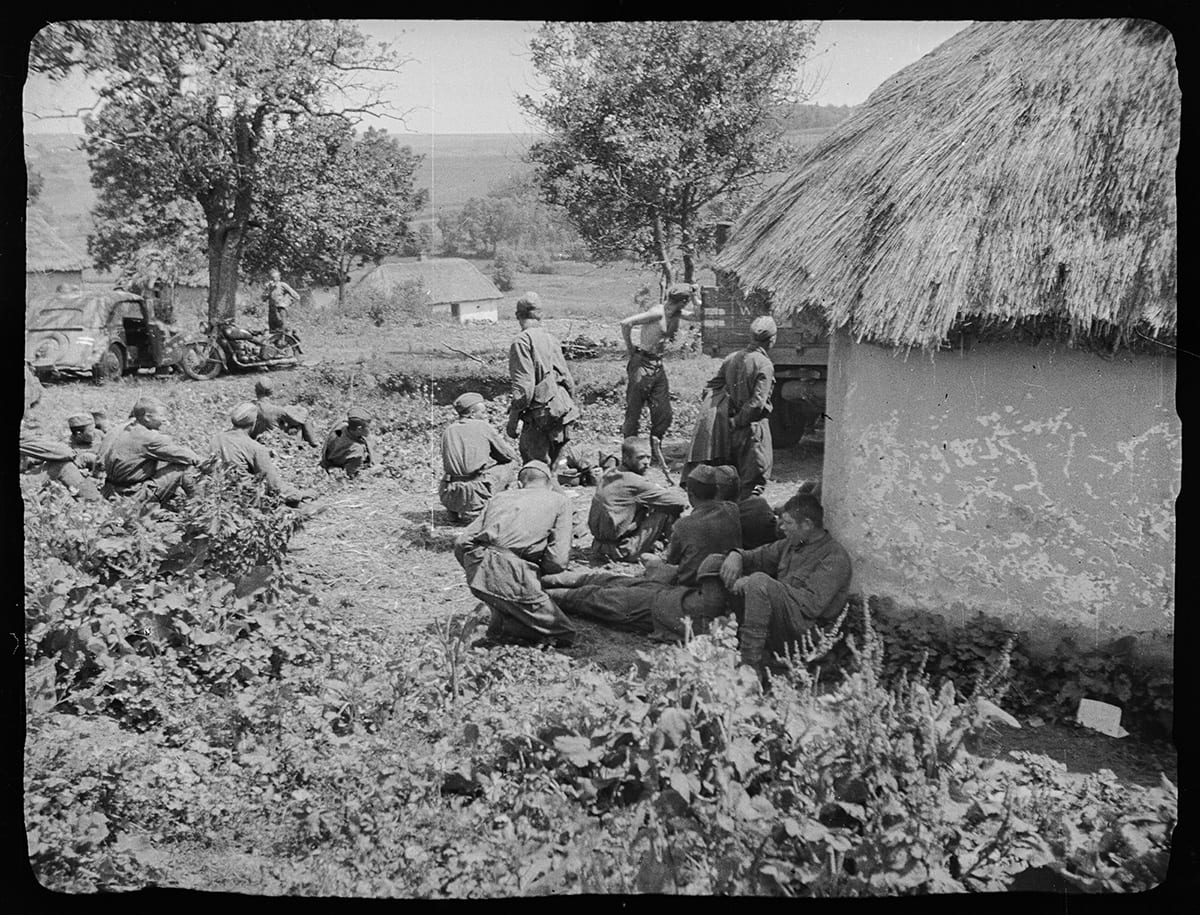
Red Army prisoners awaiting convoy near a village hut. August - September Ukraine. 1941
Red Army prisoners awaiting convoy near a village hut. August - September Ukraine. 1941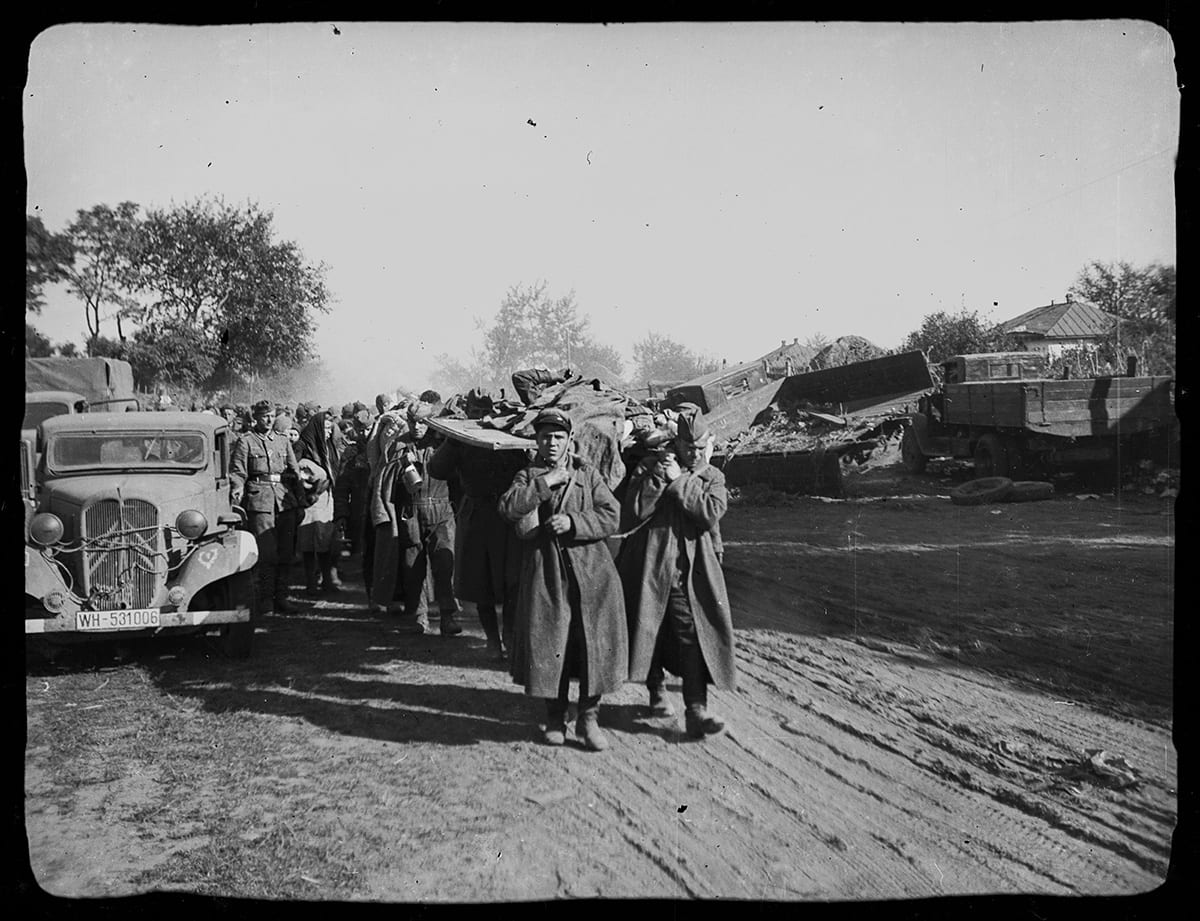
A column of Red Army prisoners. The identification mark of the 298th Infantry Division (deer skull with horns and the letter G) can be seen on the left of the German vehicle. The commander is Lieutenant General Walter Gressner. Presumably the Kiev Cauldron, Ukraine. August-September 1941
A column of Red Army prisoners. The identification mark of the 298th Infantry Division (deer skull with horns and the letter G) can be seen on the left of the German vehicle. The commander is Lieutenant General Walter Gressner. Presumably the Kiev Cauldron, Ukraine. August-September 1941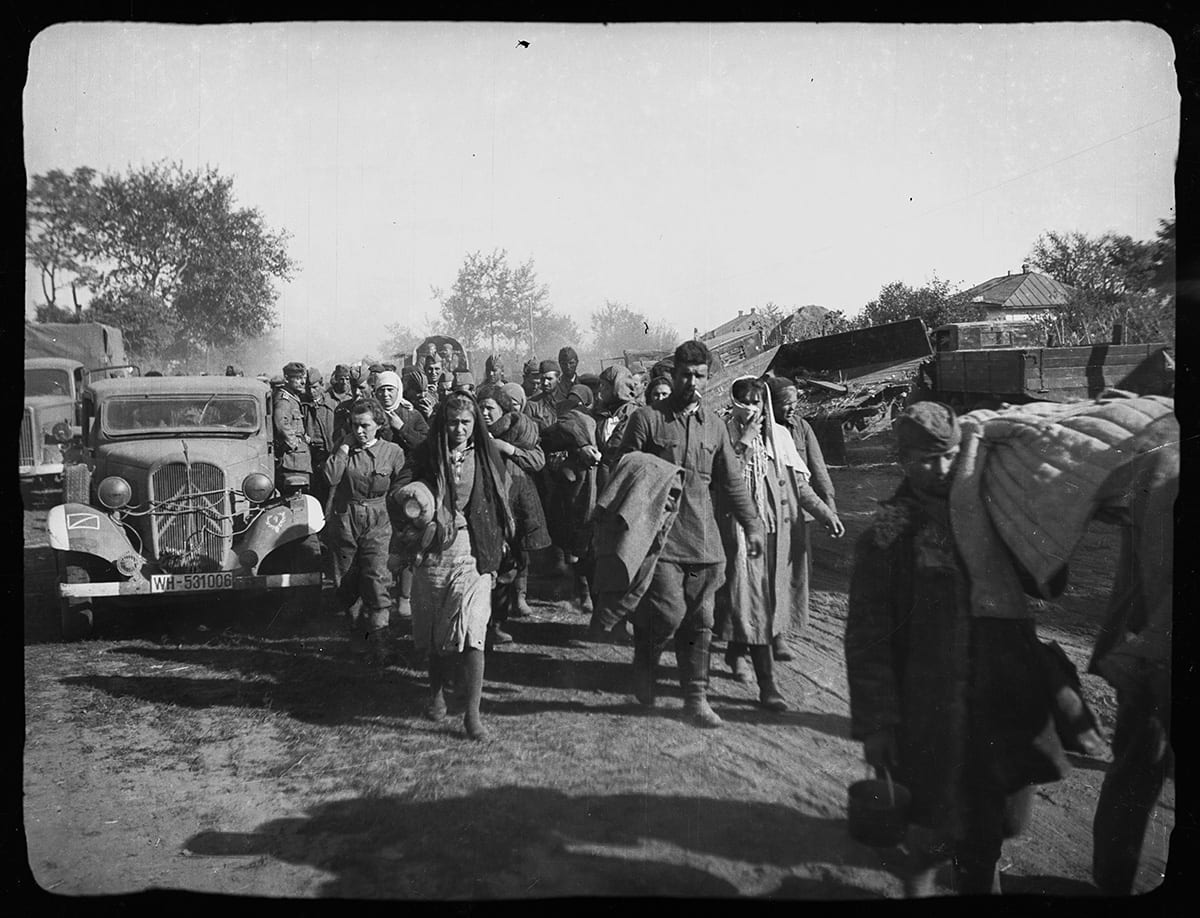
A column of Red Army prisoners. The identification mark of the 298th Infantry Division (deer skull with horns and the letter G) can be seen on the left of the German vehicle. The commander is Lieutenant General Walter Gressner. Presumably the Kiev Cauldron, Ukraine. August-September 1941
A column of Red Army prisoners. The identification mark of the 298th Infantry Division (deer skull with horns and the letter G) can be seen on the left of the German vehicle. The commander is Lieutenant General Walter Gressner. Presumably the Kiev Cauldron, Ukraine. August-September 1941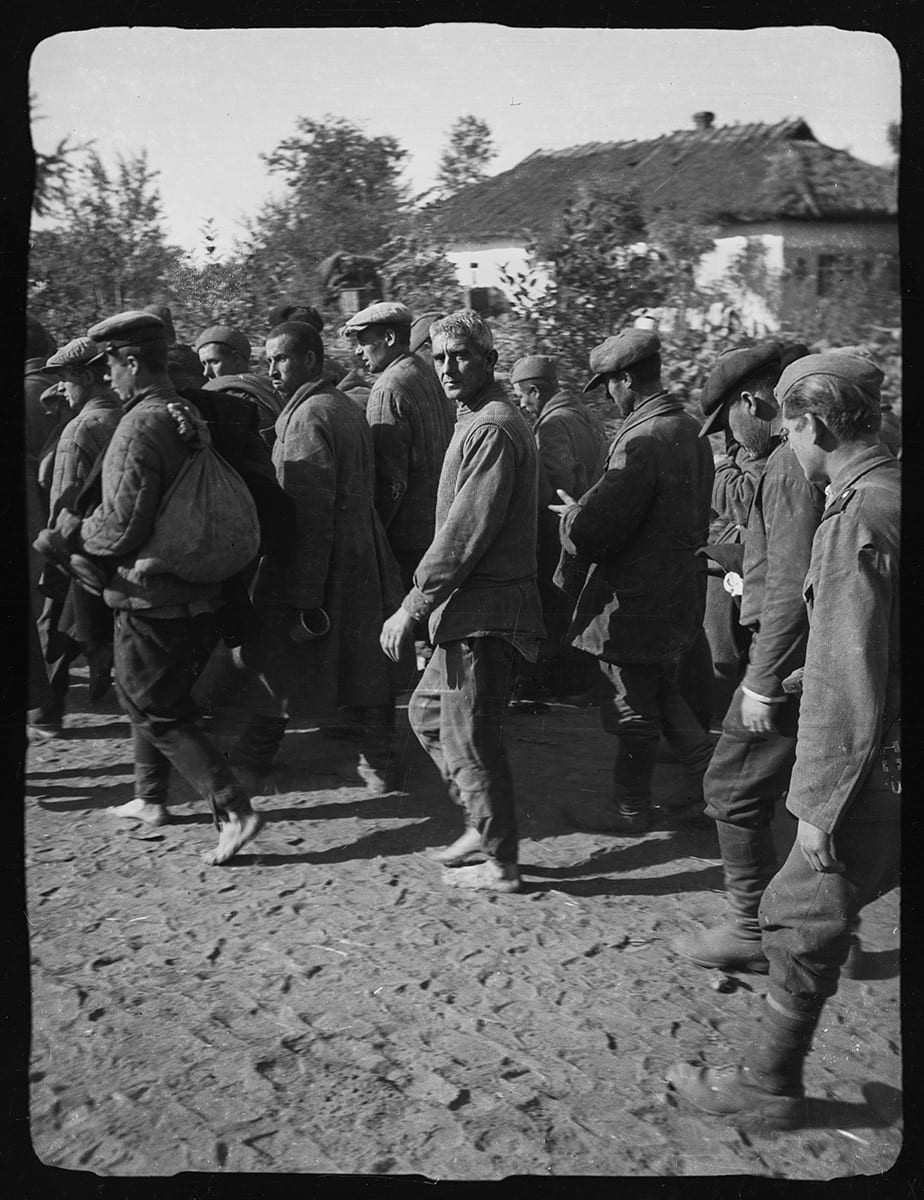
Column of Red Army prisoners. Presumably the Kiev cauldron, Ukraine. August - September 1941
Column of Red Army prisoners. Presumably the Kiev cauldron, Ukraine. August - September 1941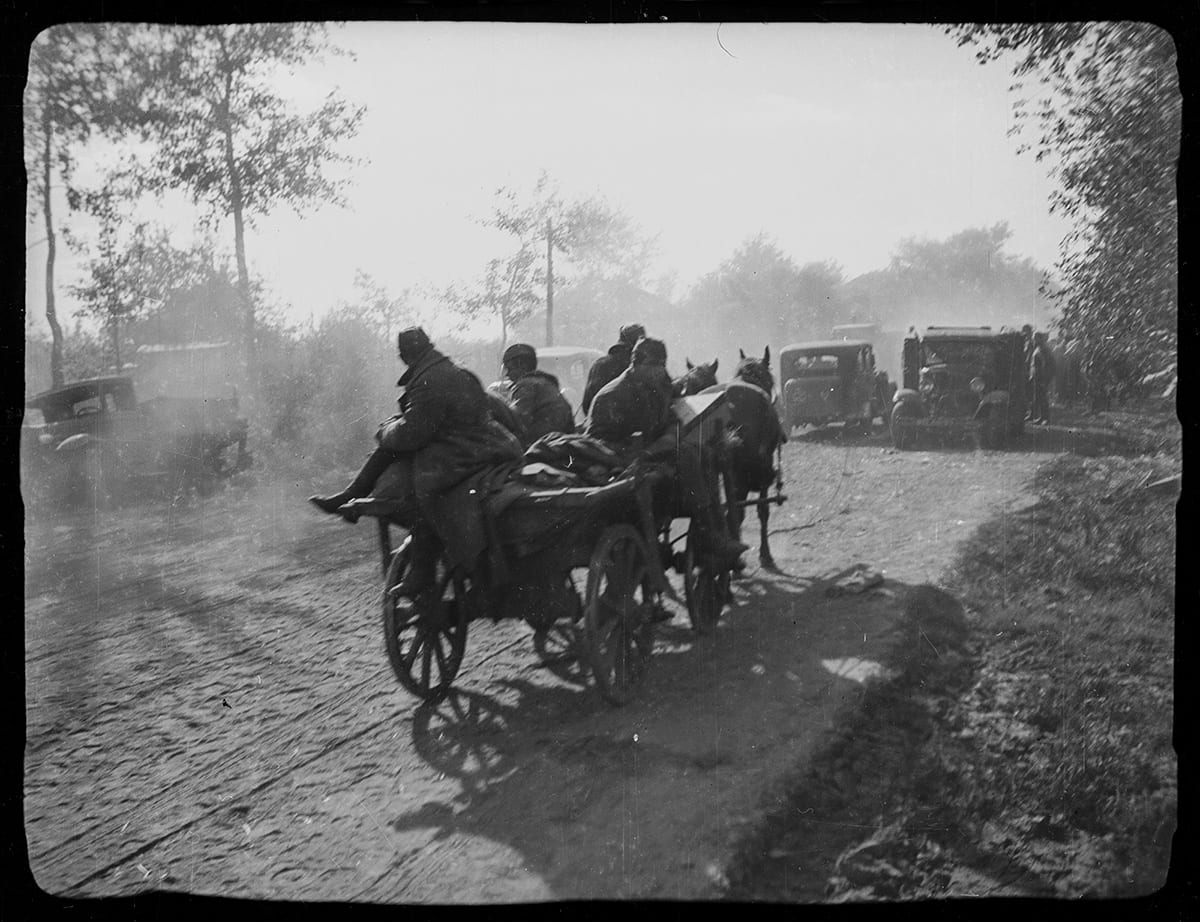
Red Army prisoners riding on a horse-drawn cart. Presumably the Kiev cauldron, Ukraine. August-September 1941
Red Army prisoners riding on a horse-drawn cart. Presumably the Kiev cauldron, Ukraine. August-September 1941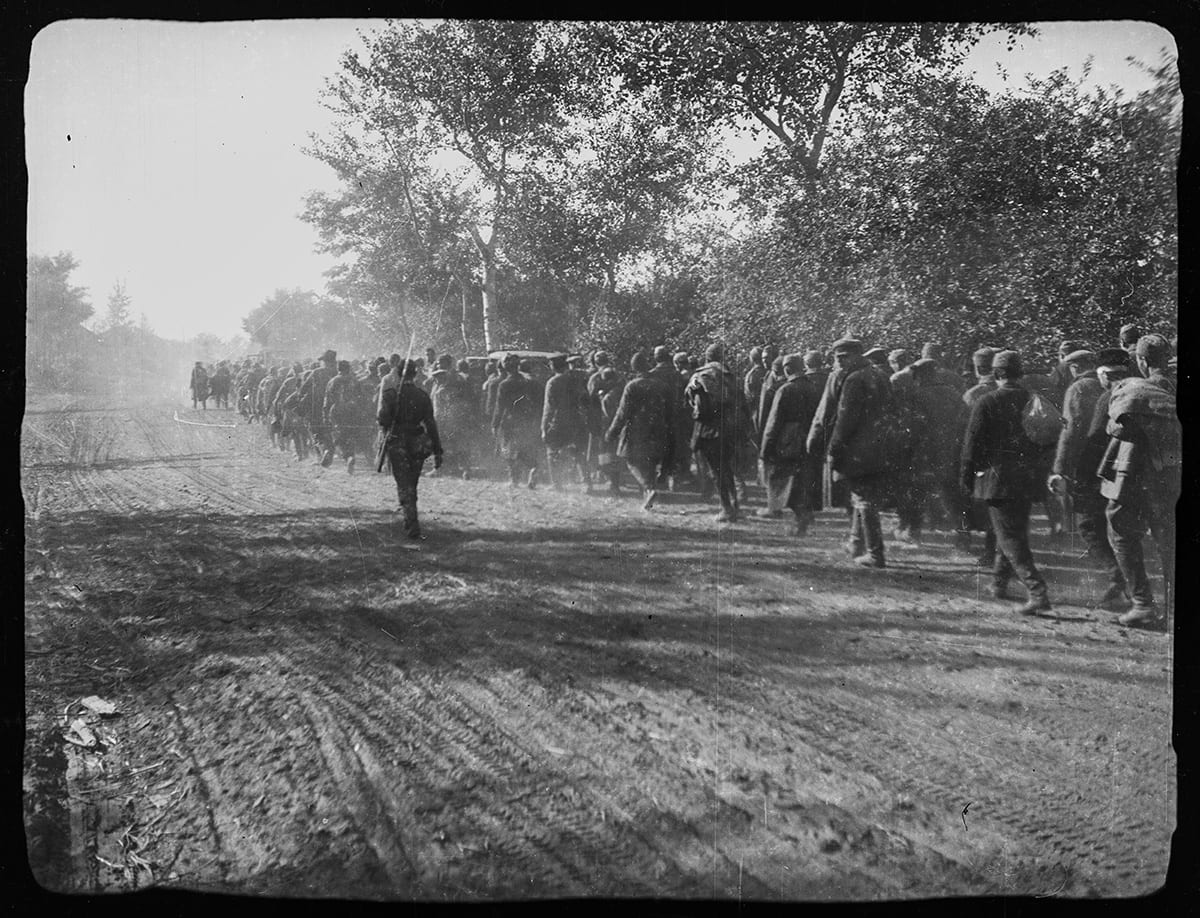
A convoy of Red Army prisoners goes under escort. Presumably the Kiev cauldron, Ukraine. August - September 1941
A convoy of Red Army prisoners goes under escort. Presumably the Kiev cauldron, Ukraine. August - September 1941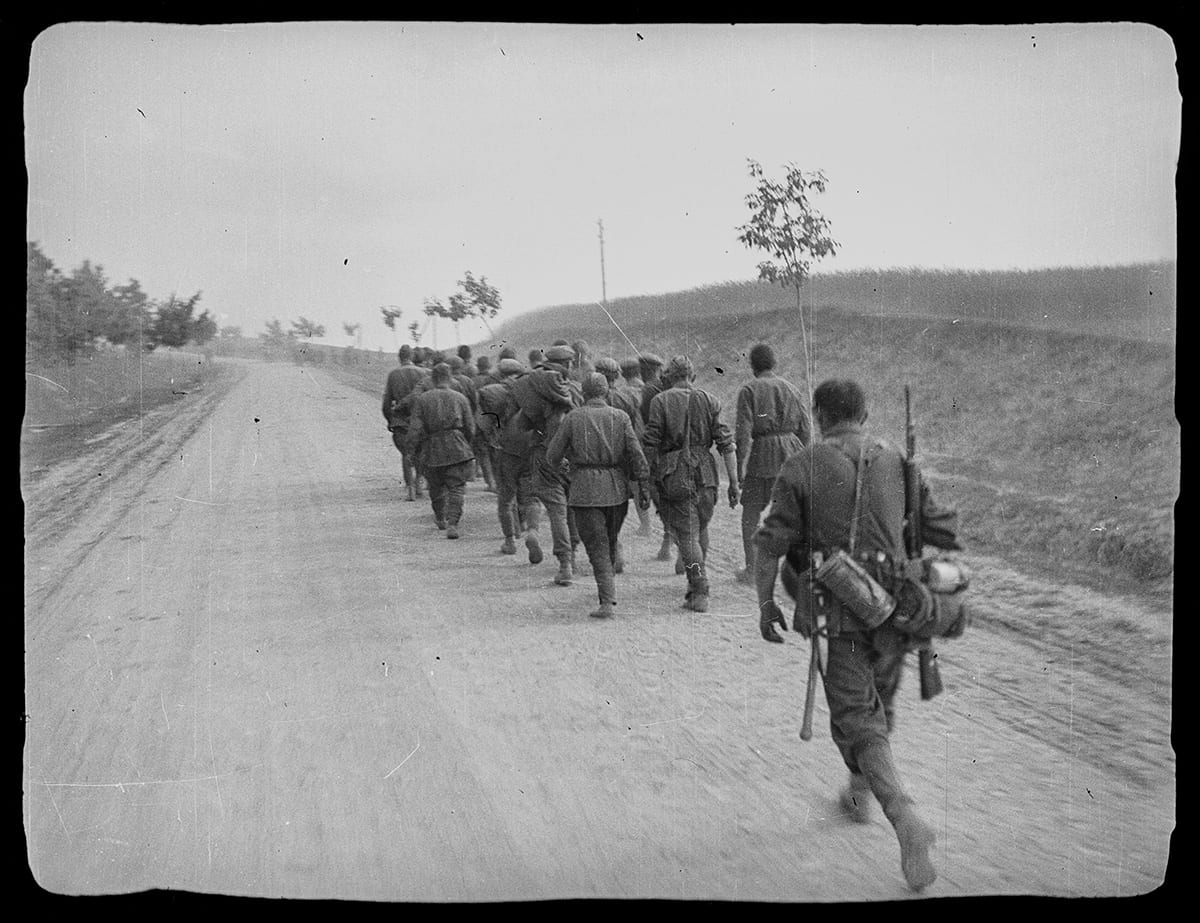
A convoy of Red Army prisoners goes under escort. Presumably the Kiev cauldron, Ukraine. August - September 1941
A convoy of Red Army prisoners goes under escort. Presumably the Kiev cauldron, Ukraine. August - September 1941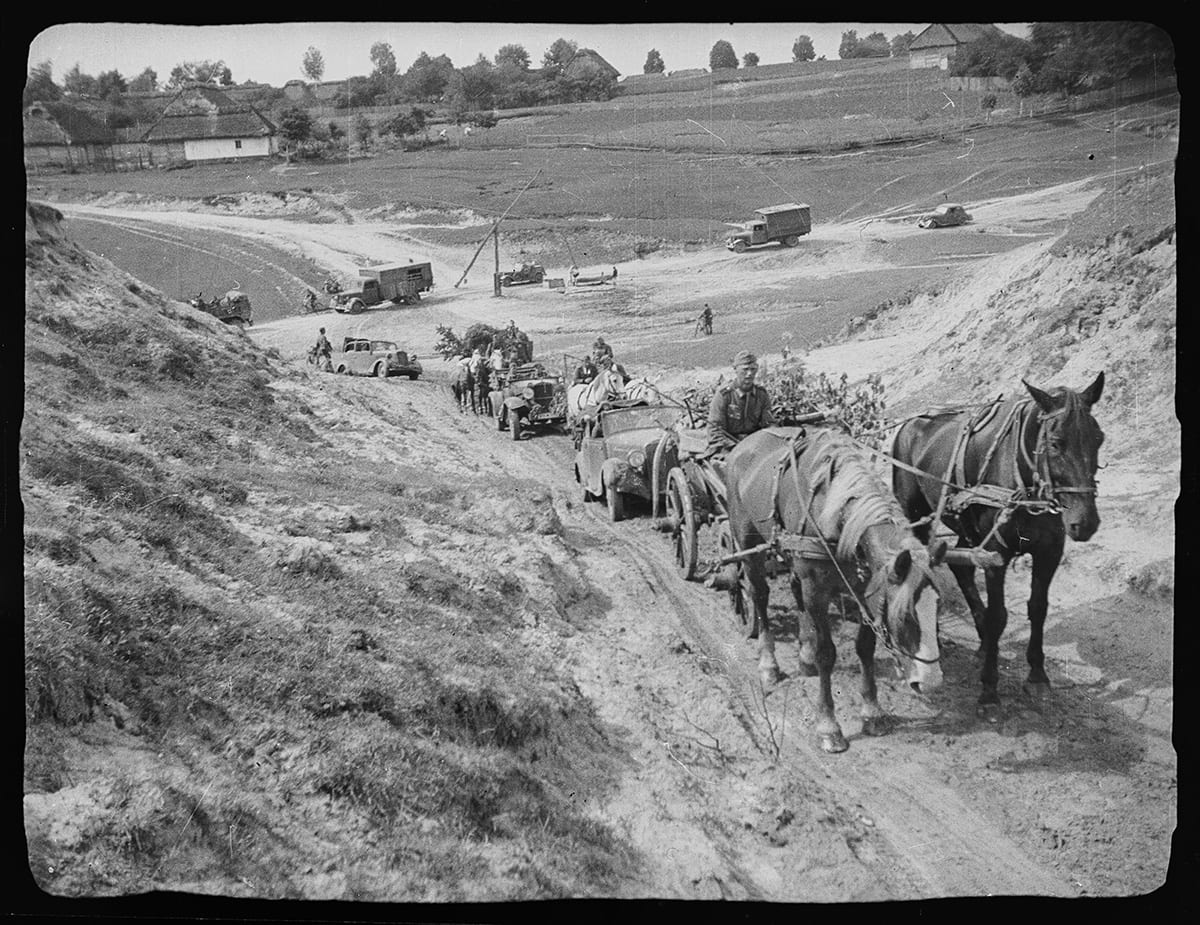
Advancement of the German Army. Ukraine. August - September 1941
Advancement of the German Army. Ukraine. August - September 1941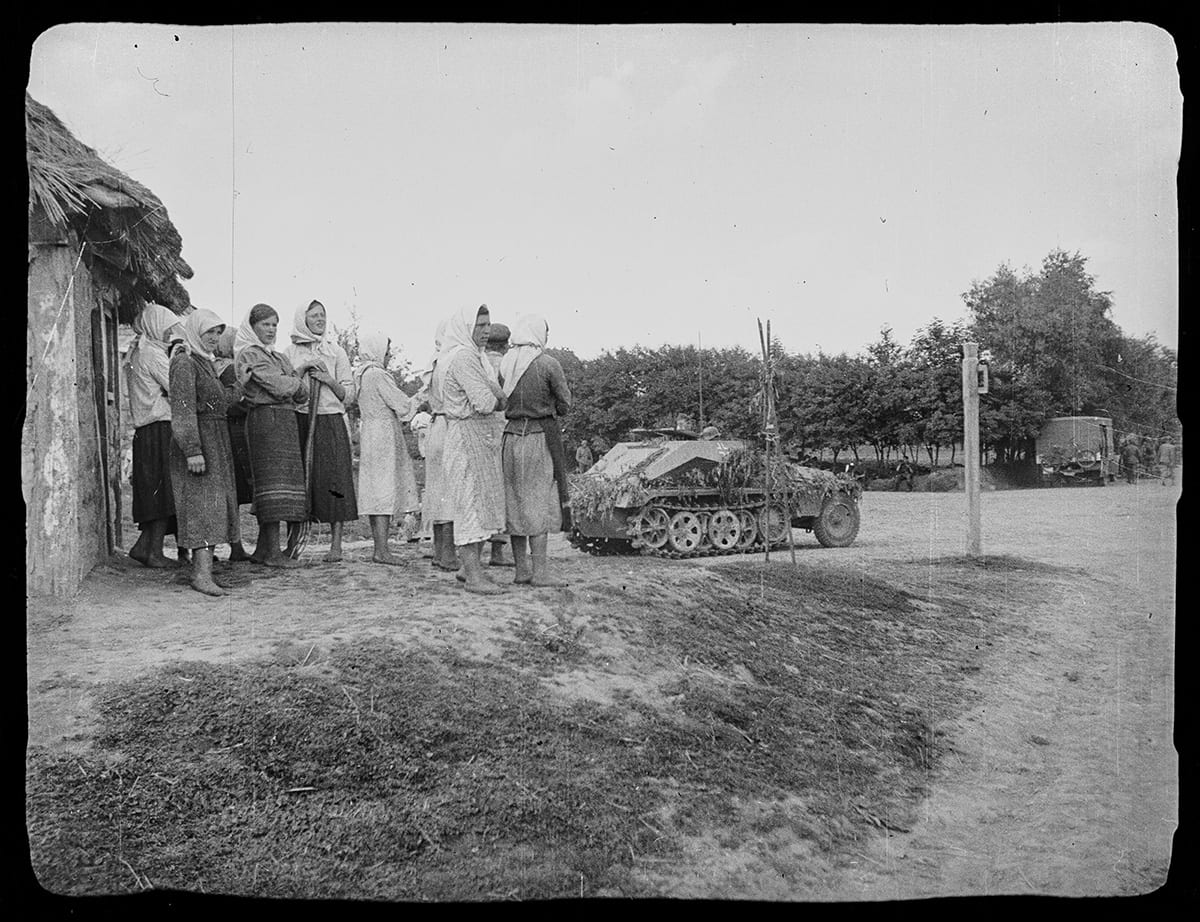
Locals watch as a German convoy moves through their occupied village. A German Sd Kfz 250 light semi-tracked armored personnel carrier is moving along the road. Ukraine. August - September 1941
Locals watch as a German convoy moves through their occupied village. A German Sd Kfz 250 light semi-tracked armored personnel carrier is moving along the road. Ukraine. August - September 1941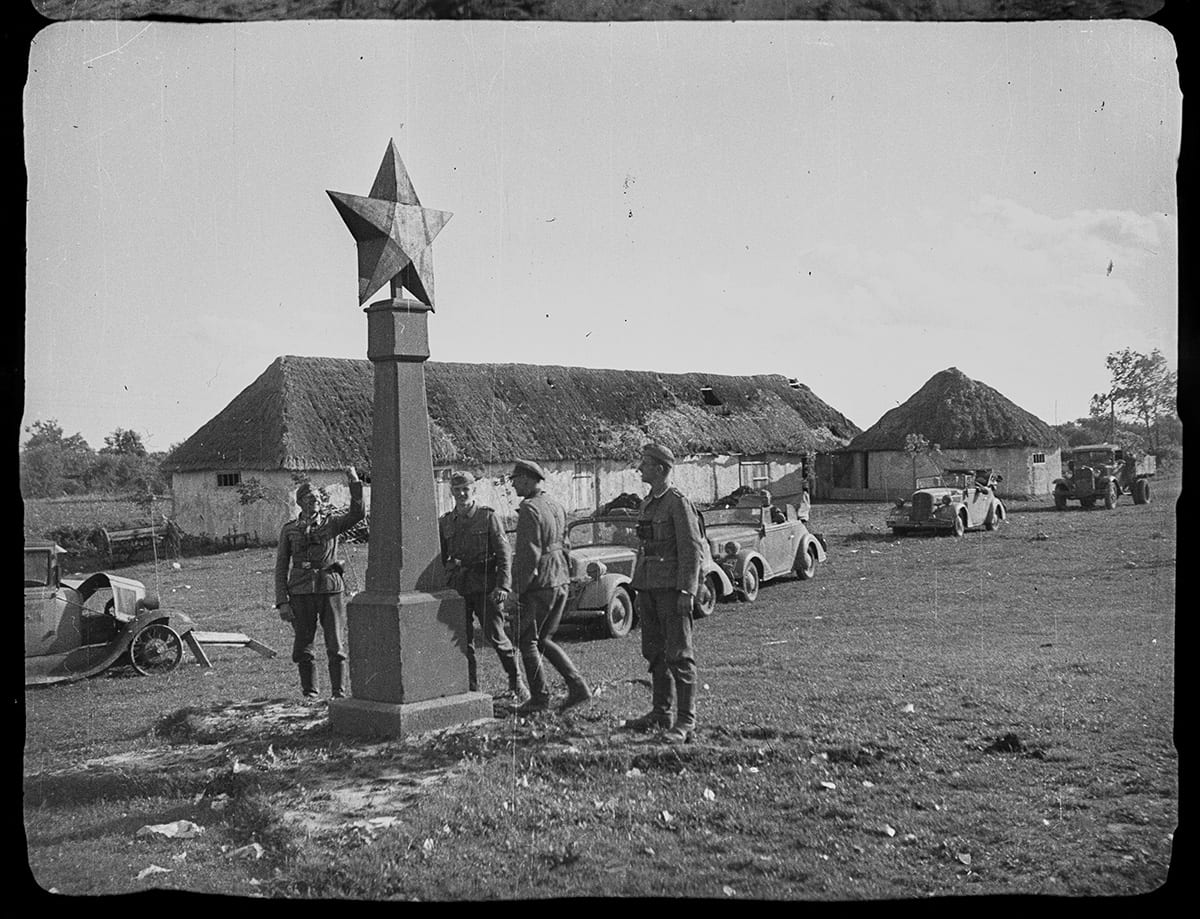
German military near the stele with the Soviet five-pointed star on top. Ukraine. August - September 1941
German military near the stele with the Soviet five-pointed star on top. Ukraine. August - September 1941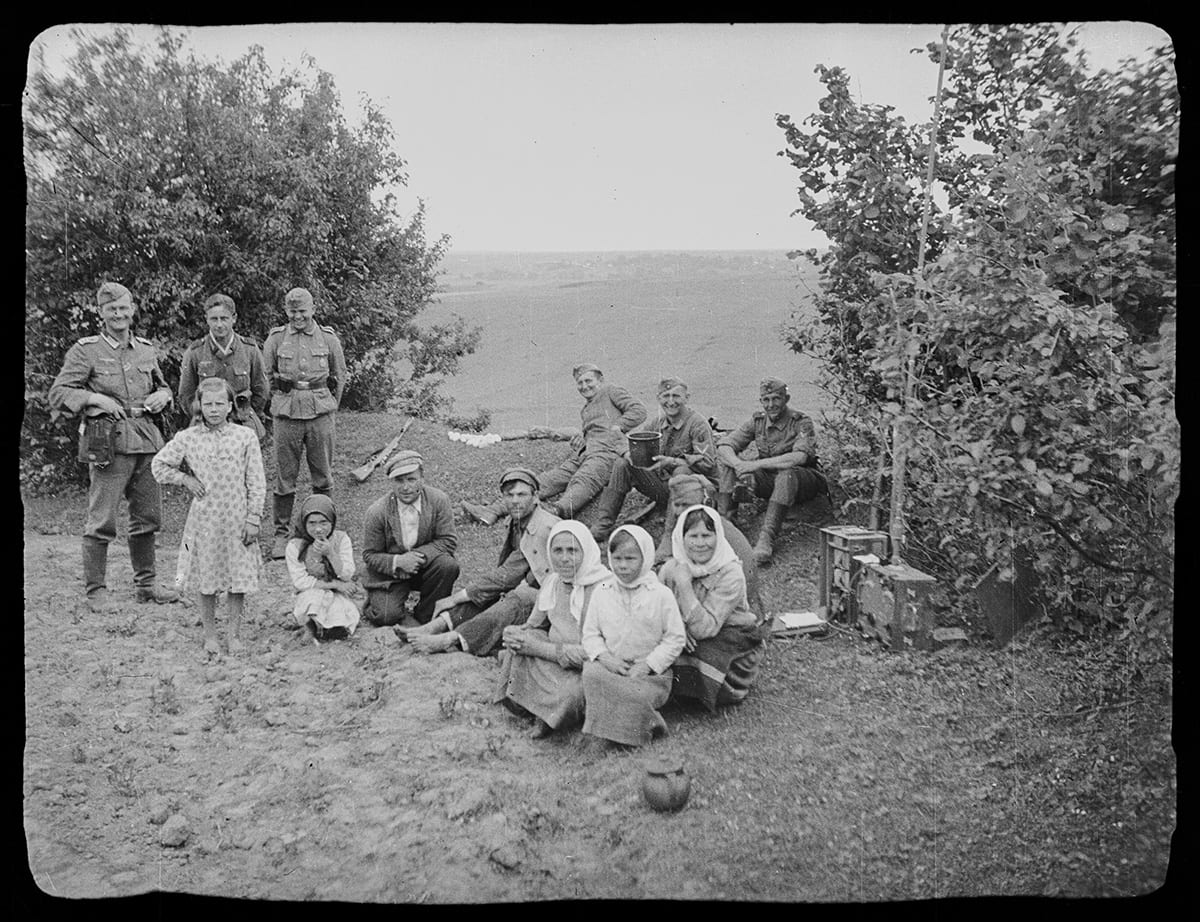
German soldiers at their position with a radio station. Next to them sit local residents who apparently brought them food. Ukraine. August - September 1941
German soldiers at their position with a radio station. Next to them sit local residents who apparently brought them food. Ukraine. August - September 1941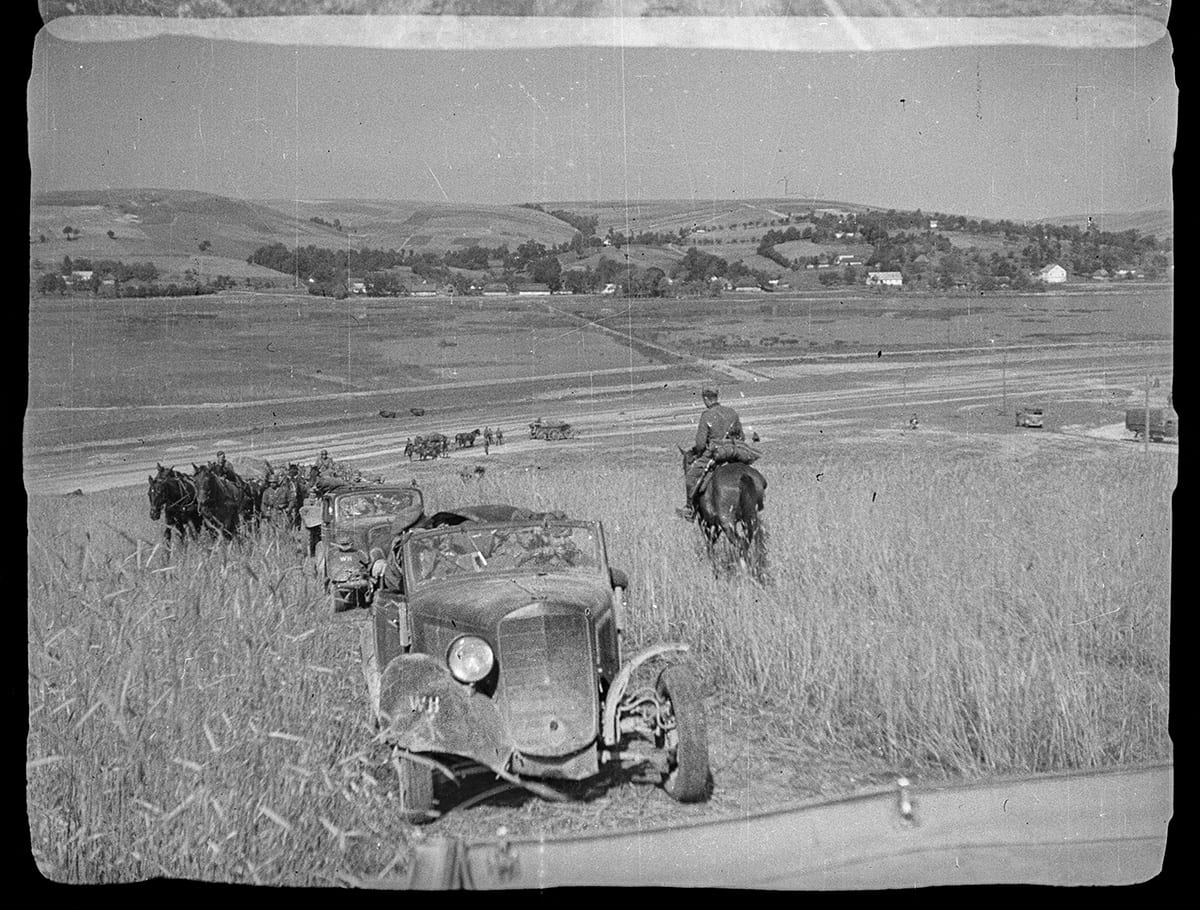
Marching of the German army. In the foreground there is a German car Mercedes-Benz 170V. Ukraine. August - September 1941
Marching of the German army. In the foreground there is a German car Mercedes-Benz 170V. Ukraine. August - September 1941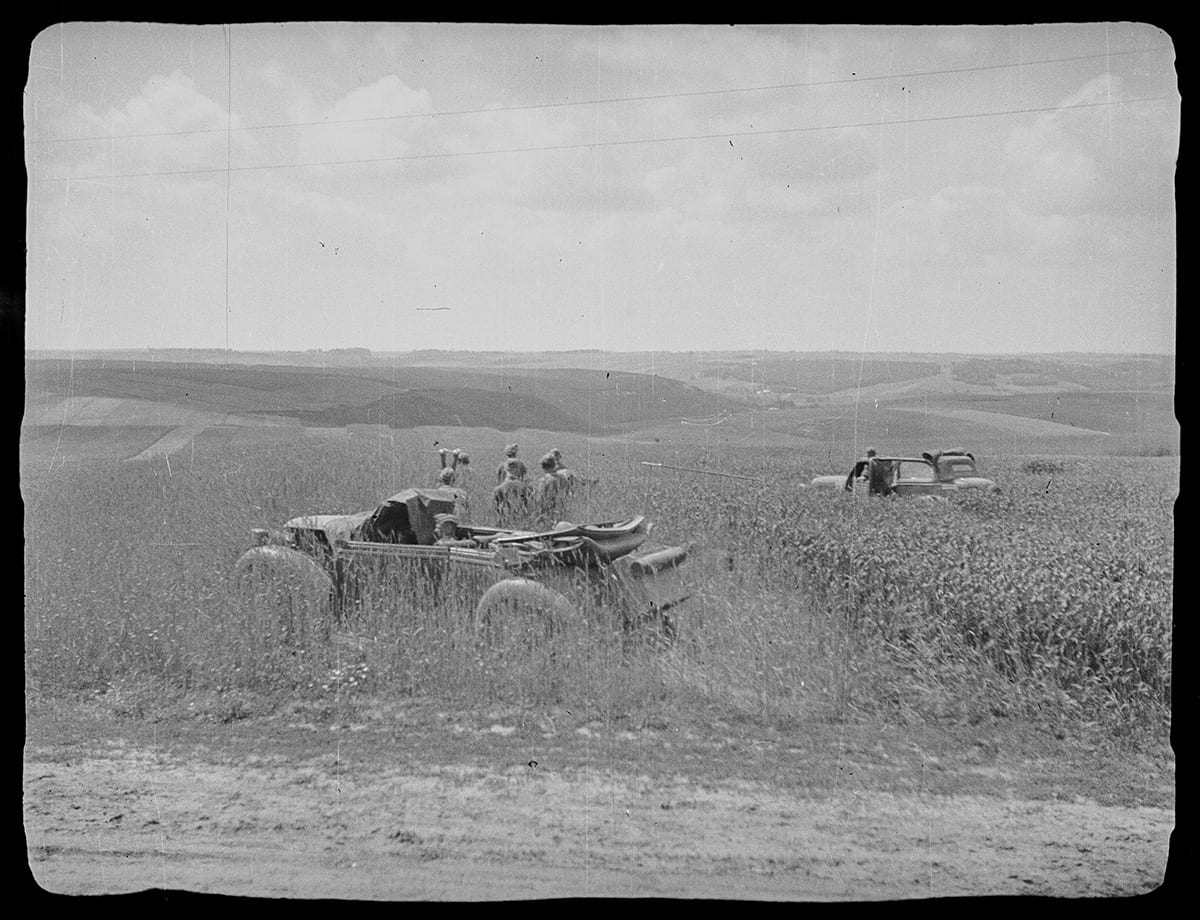
A military convoy stopped to observe the situation in an army rangefinder. In the foreground is a German Horch 901 off-road vehicle. Ukraine. August - September 1941
A military convoy stopped to observe the situation in an army rangefinder. In the foreground is a German Horch 901 off-road vehicle. Ukraine. August - September 1941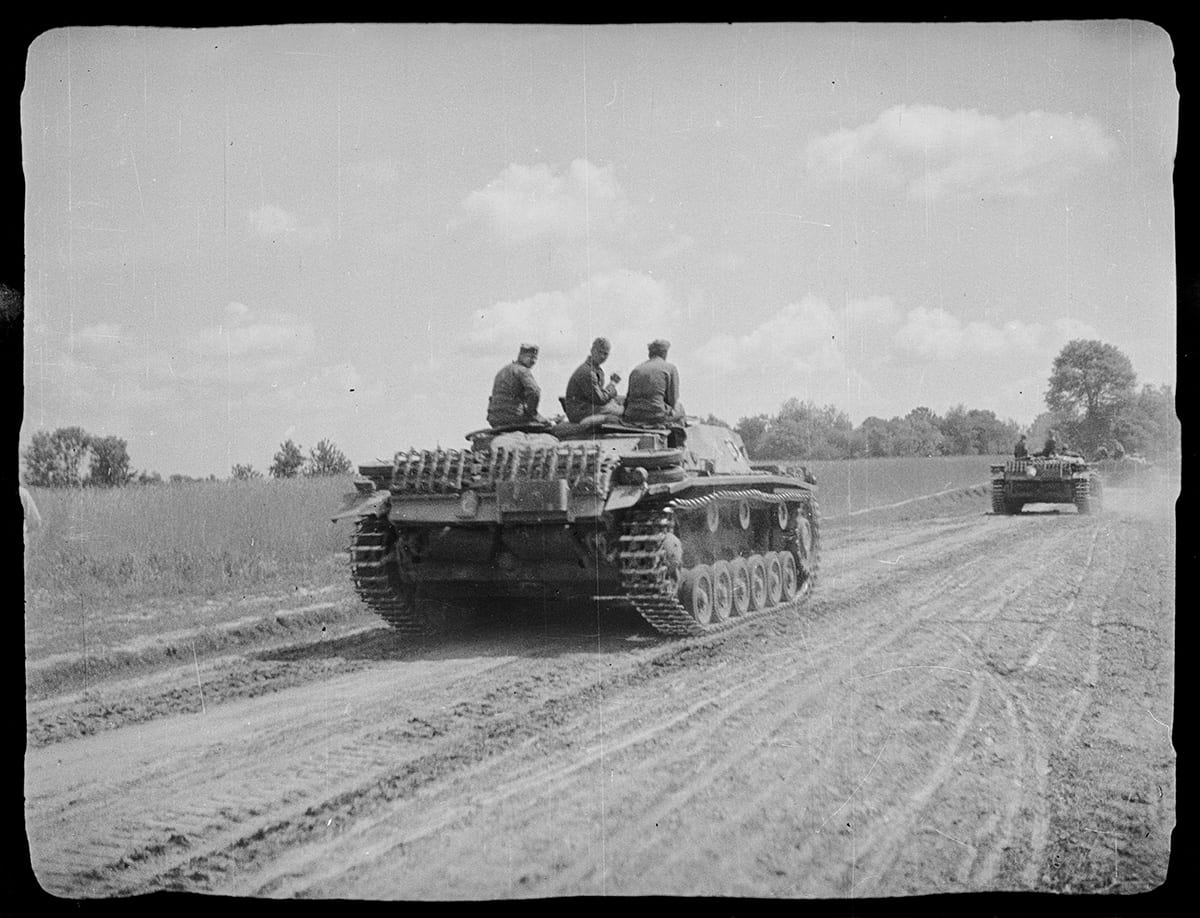
Column of German medium tanks Pz.Kpfw. III. Ukraine. August - September 1941
Column of German medium tanks Pz.Kpfw. III. Ukraine. August - September 1941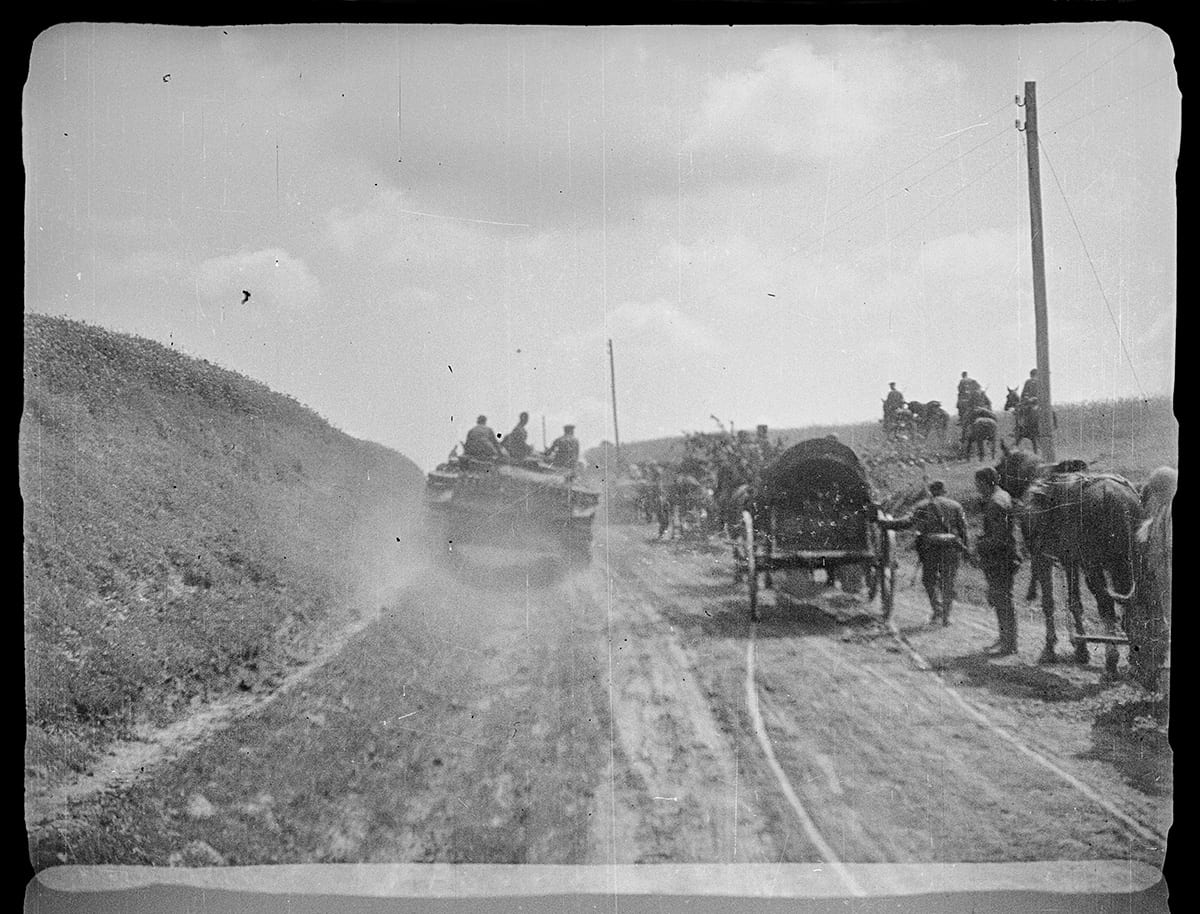
A column of German troops passes German medium tanks Pz.Kpfw. III. Ukraine. August - September 1941
A column of German troops passes German medium tanks Pz.Kpfw. III. Ukraine. August - September 1941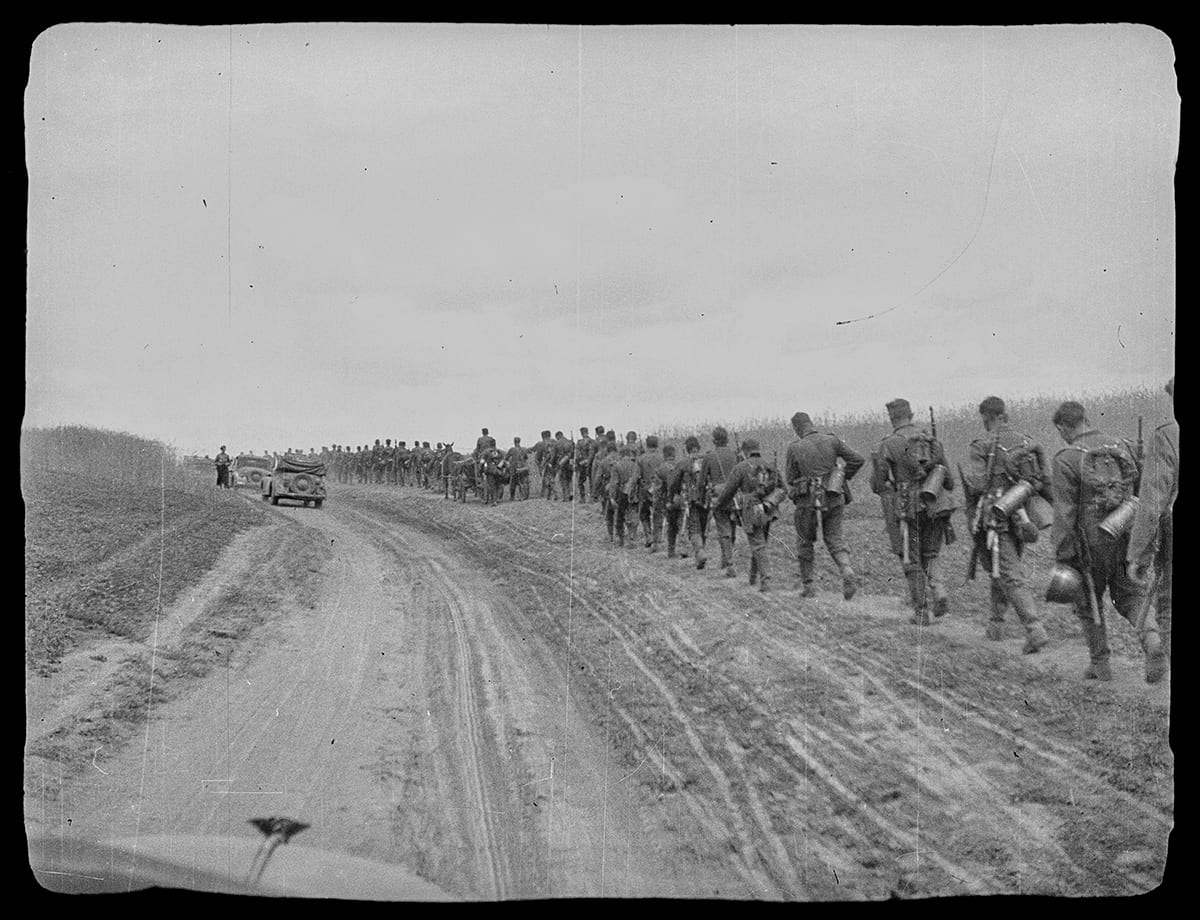
A column of German infantry is walking along the edge of the road, while a column of cars is moving along it. Ukraine. August - September 1941
A column of German infantry is walking along the edge of the road, while a column of cars is moving along it. Ukraine. August - September 1941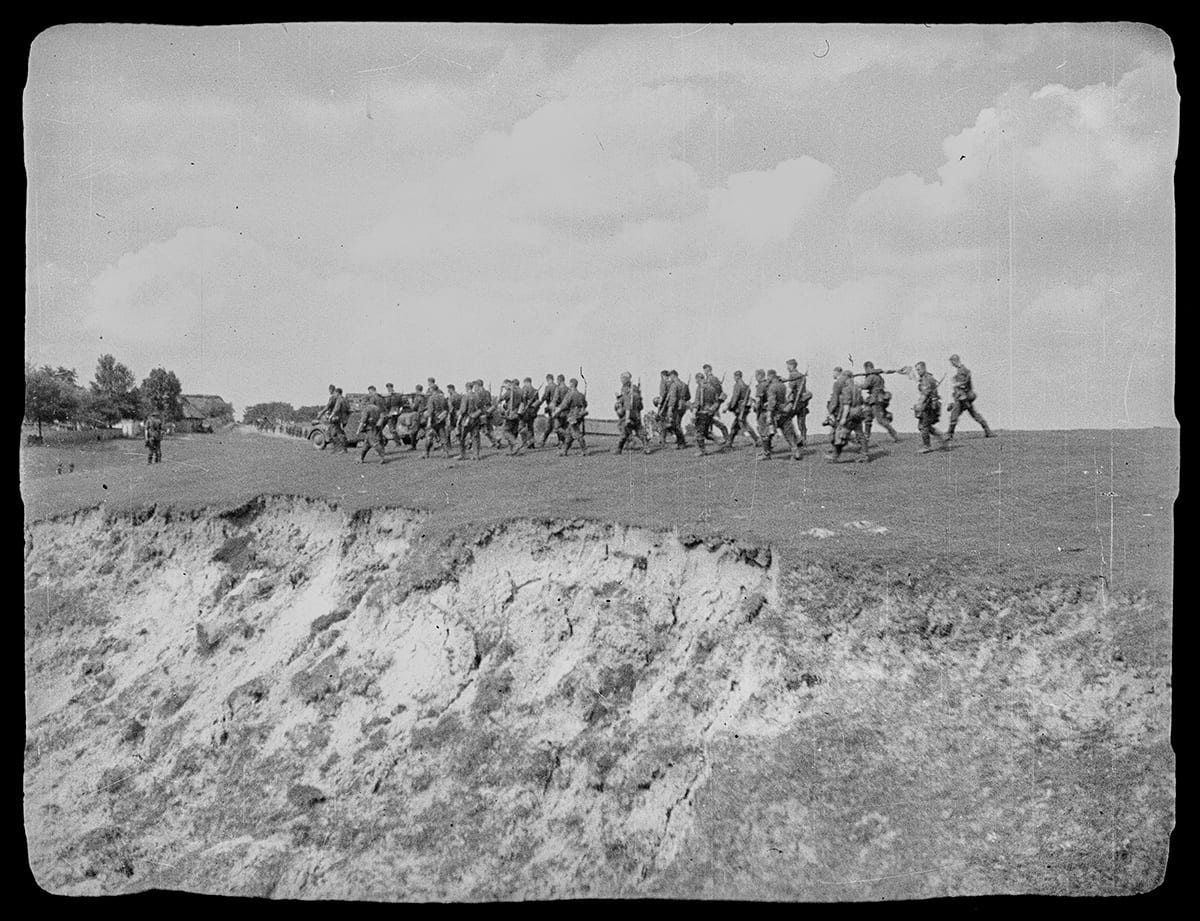
A convoy of the German army enters one of the Ukrainian villages. Ukraine. August - September 1941
A convoy of the German army enters one of the Ukrainian villages. Ukraine. August - September 1941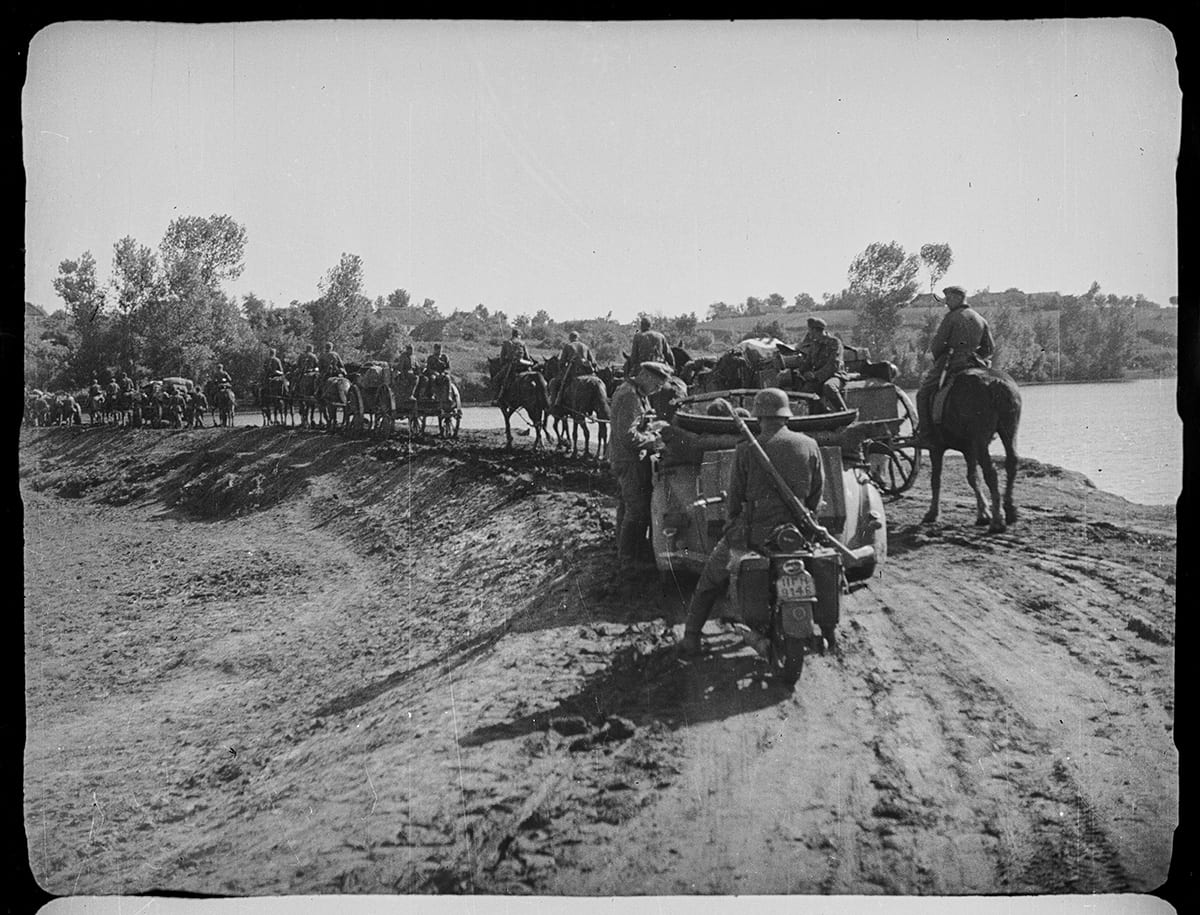
Advance of the German army along a dam in one of the Ukrainian villages. Ukraine. August - September 1941
Advance of the German army along a dam in one of the Ukrainian villages. Ukraine. August - September 1941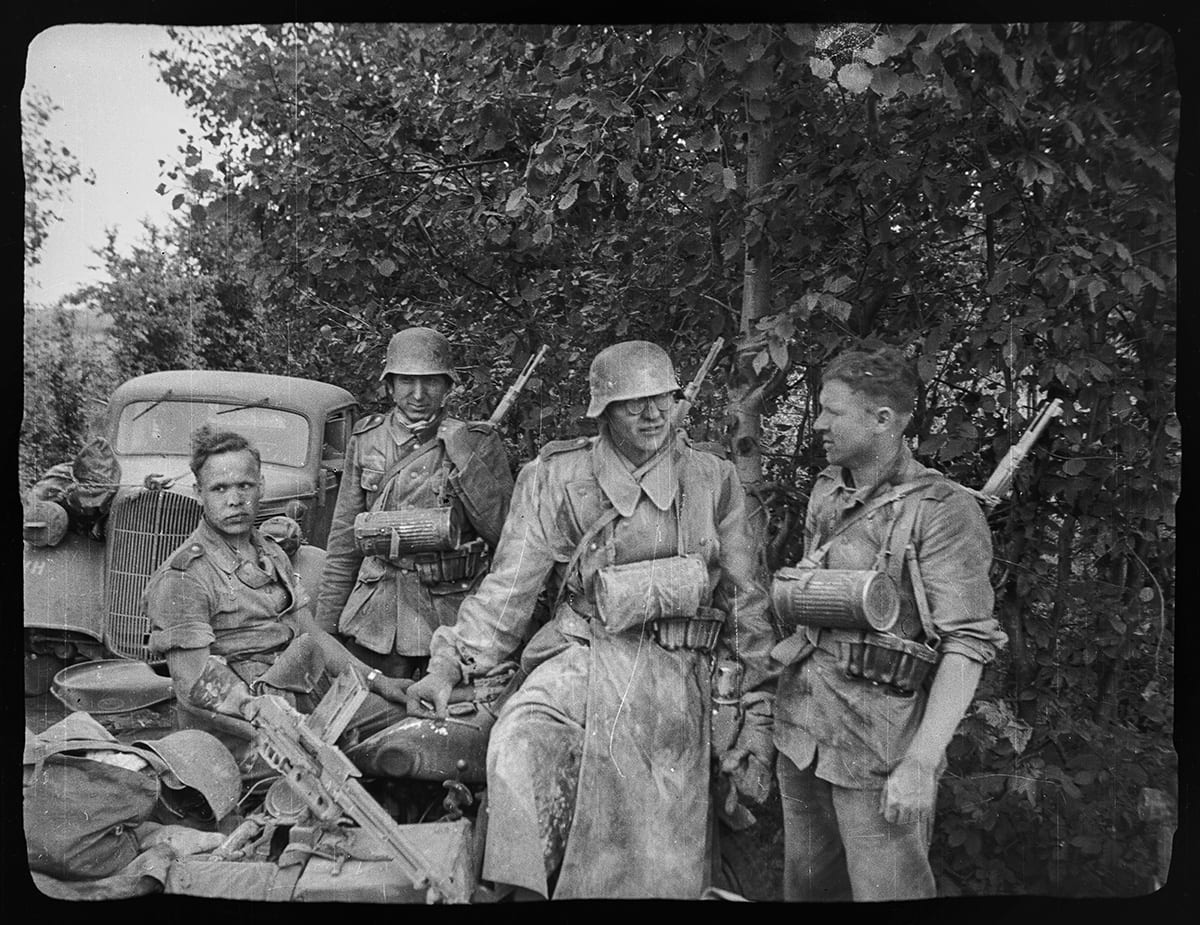
German Army convoy during a halt. There are motorcyclists in the foreground. Ukraine. August - September 1941
German Army convoy during a halt. There are motorcyclists in the foreground. Ukraine. August - September 1941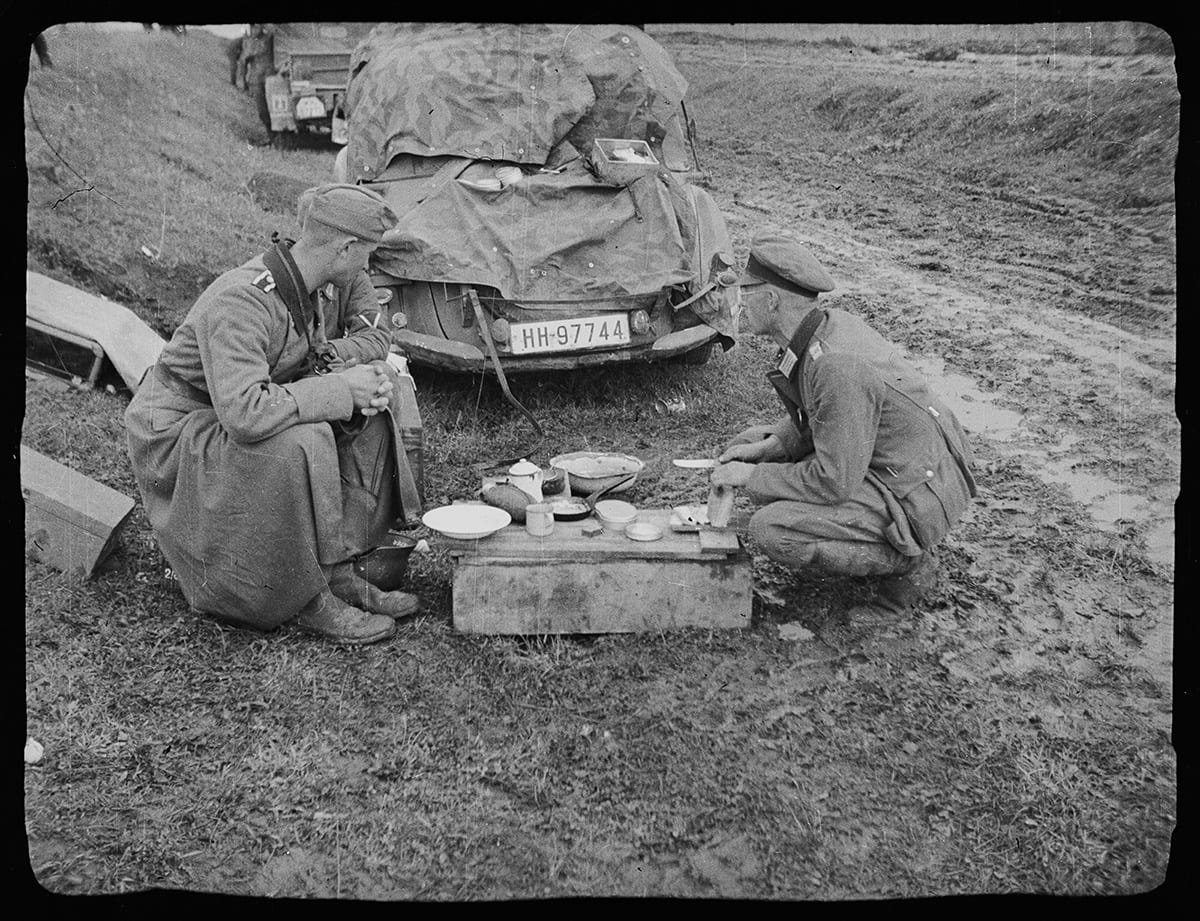
German soldiers are preparing lunch during a halt. Ukraine. August - September 1941
German soldiers are preparing lunch during a halt. Ukraine. August - September 1941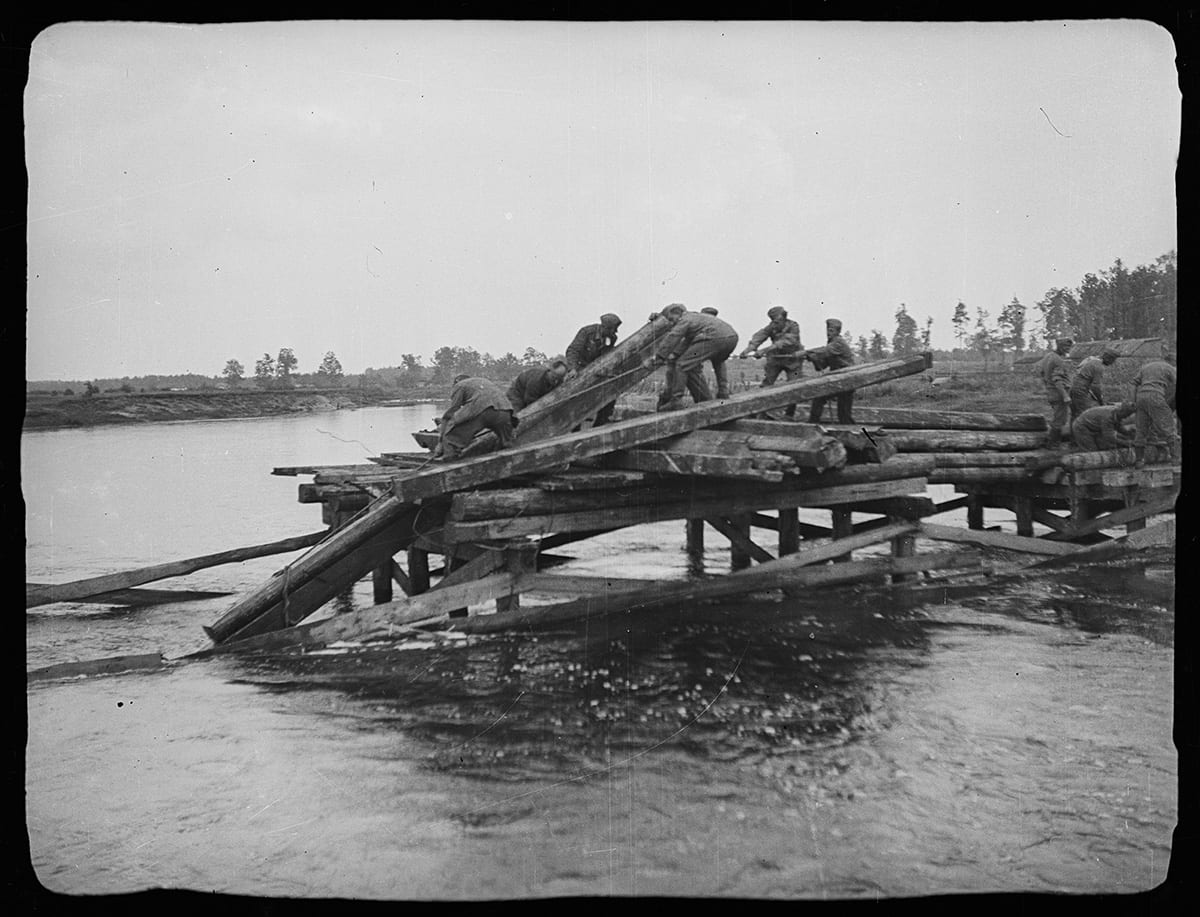
German soldiers are trying to repair the destroyed bridge over the river. Ukraine. August - September 1941
German soldiers are trying to repair the destroyed bridge over the river. Ukraine. August - September 1941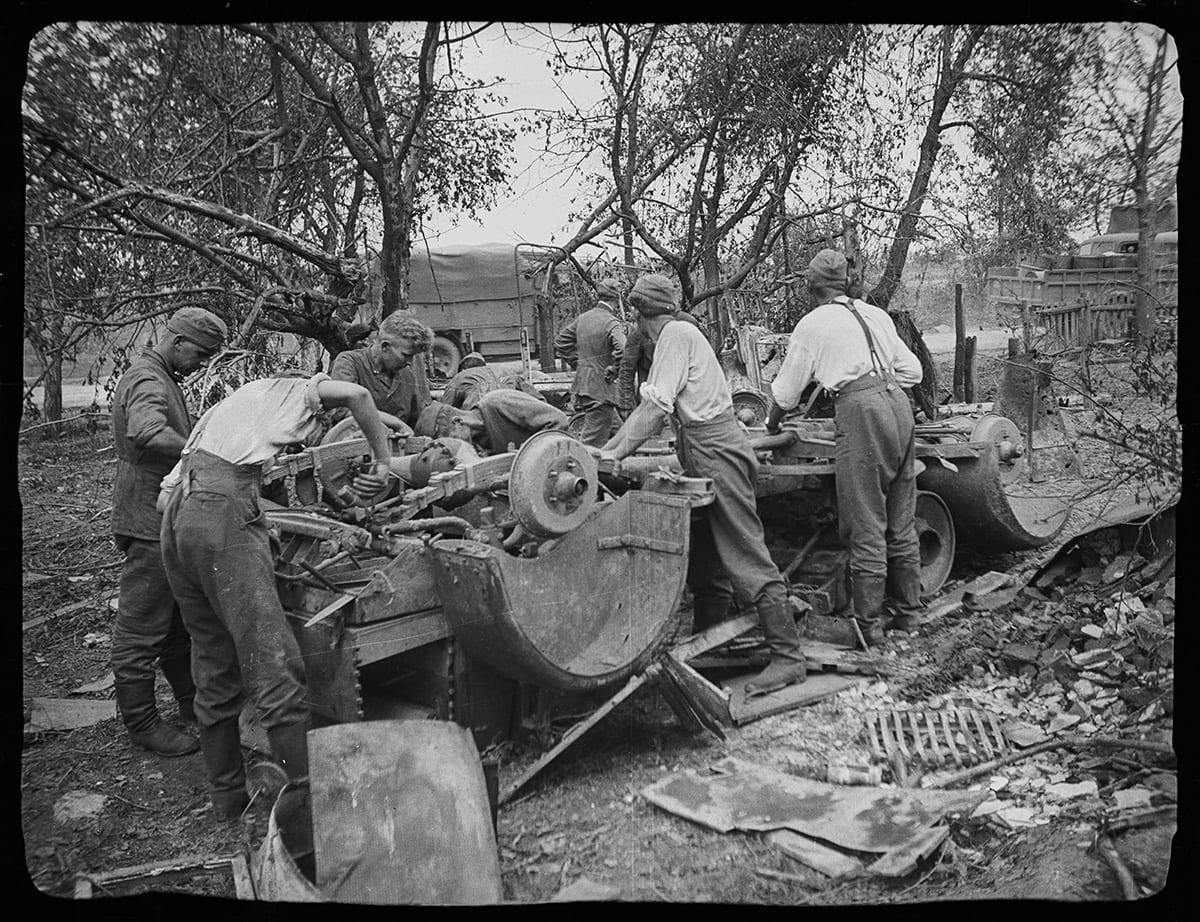
German military removes working parts from broken equipment that can still be used. Ukraine. August - September 1941
German military removes working parts from broken equipment that can still be used. Ukraine. August - September 1941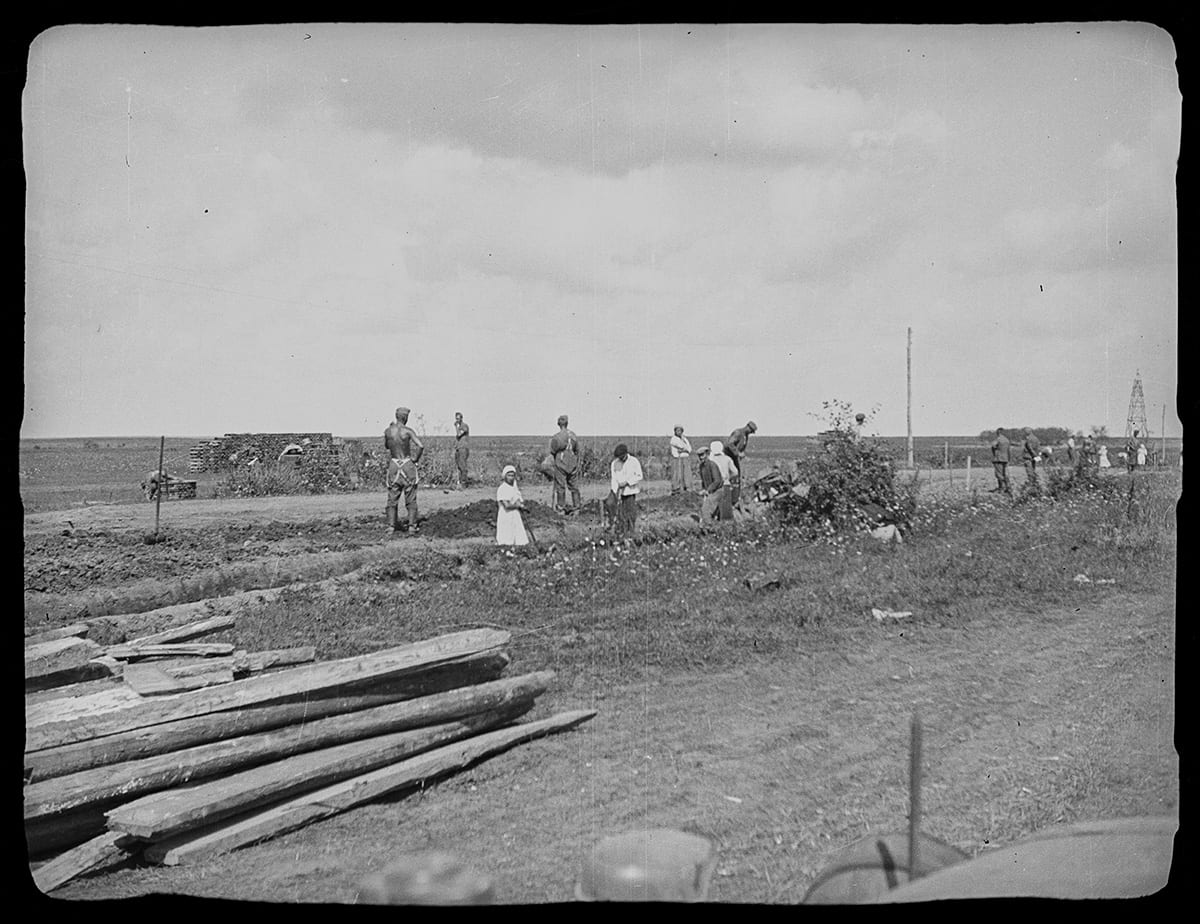
Civilians under the supervision of the German military dig trenches along the road. Ukraine. August - September 1941
Civilians under the supervision of the German military dig trenches along the road. Ukraine. August - September 1941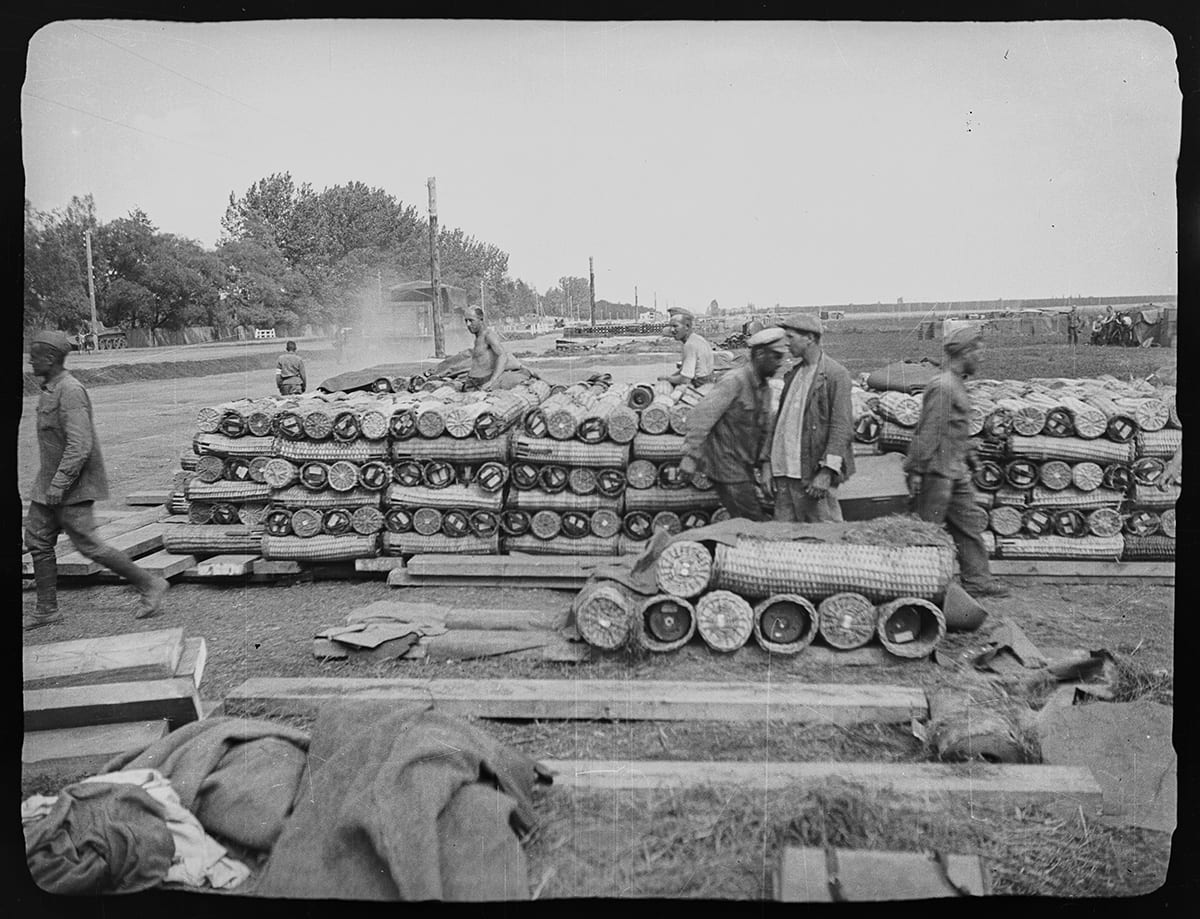
Soviet prisoners of war are bringing the German artillery shells. Ukraine. August - September 1941
Soviet prisoners of war are bringing the German artillery shells. Ukraine. August - September 1941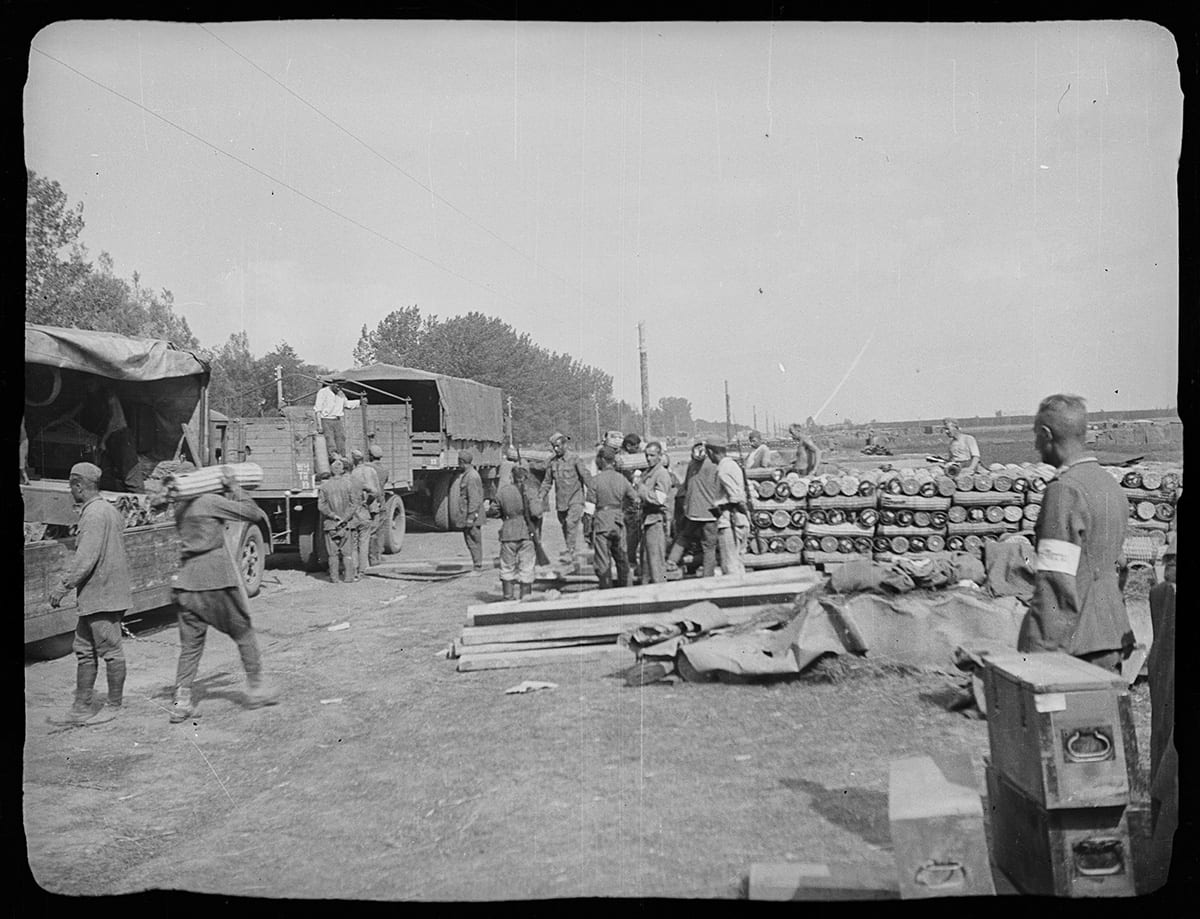
Soviet prisoners of war are bringing the German artillery shells. Ukraine. August - September 1941
Soviet prisoners of war are bringing the German artillery shells. Ukraine. August - September 1941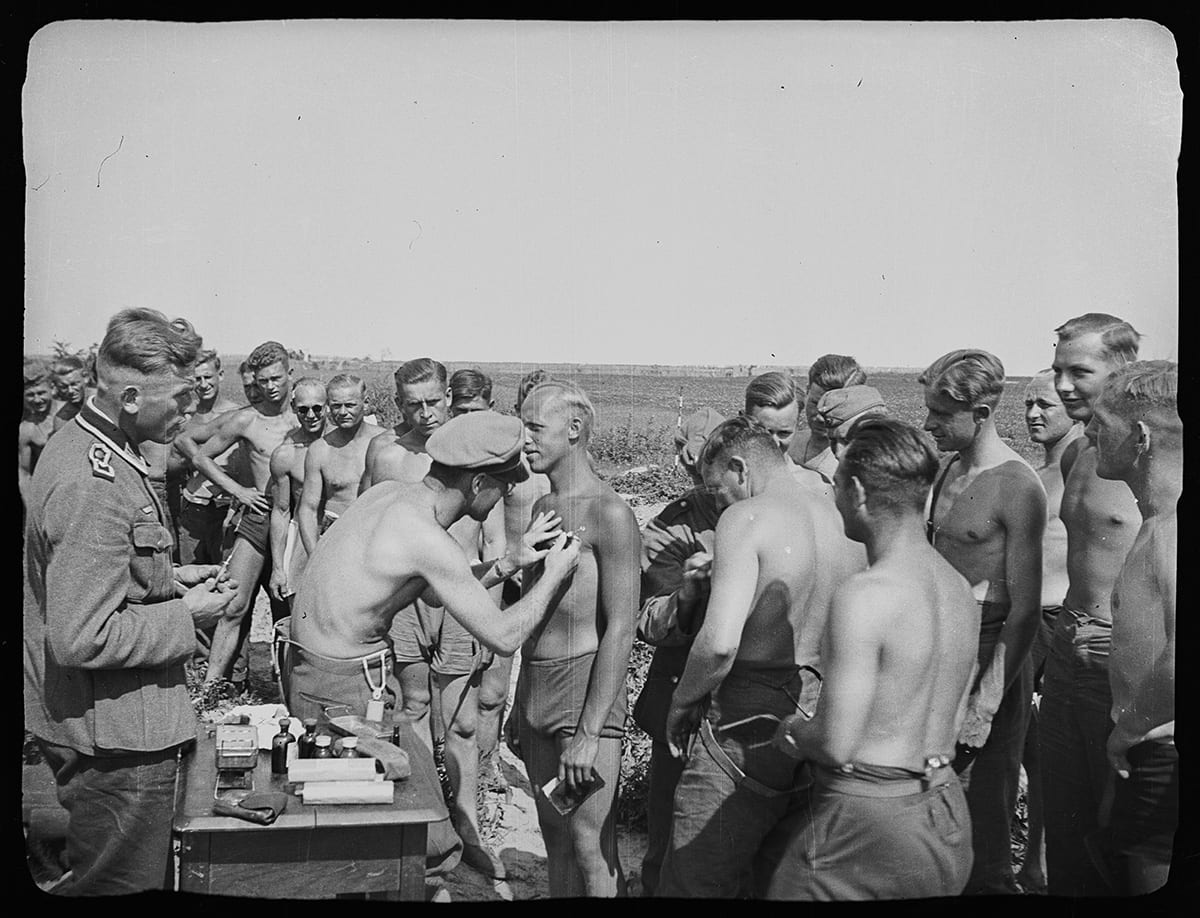
Vaccination of German soldiers. Ukraine. August - September 1941
Vaccination of German soldiers. Ukraine. August - September 1941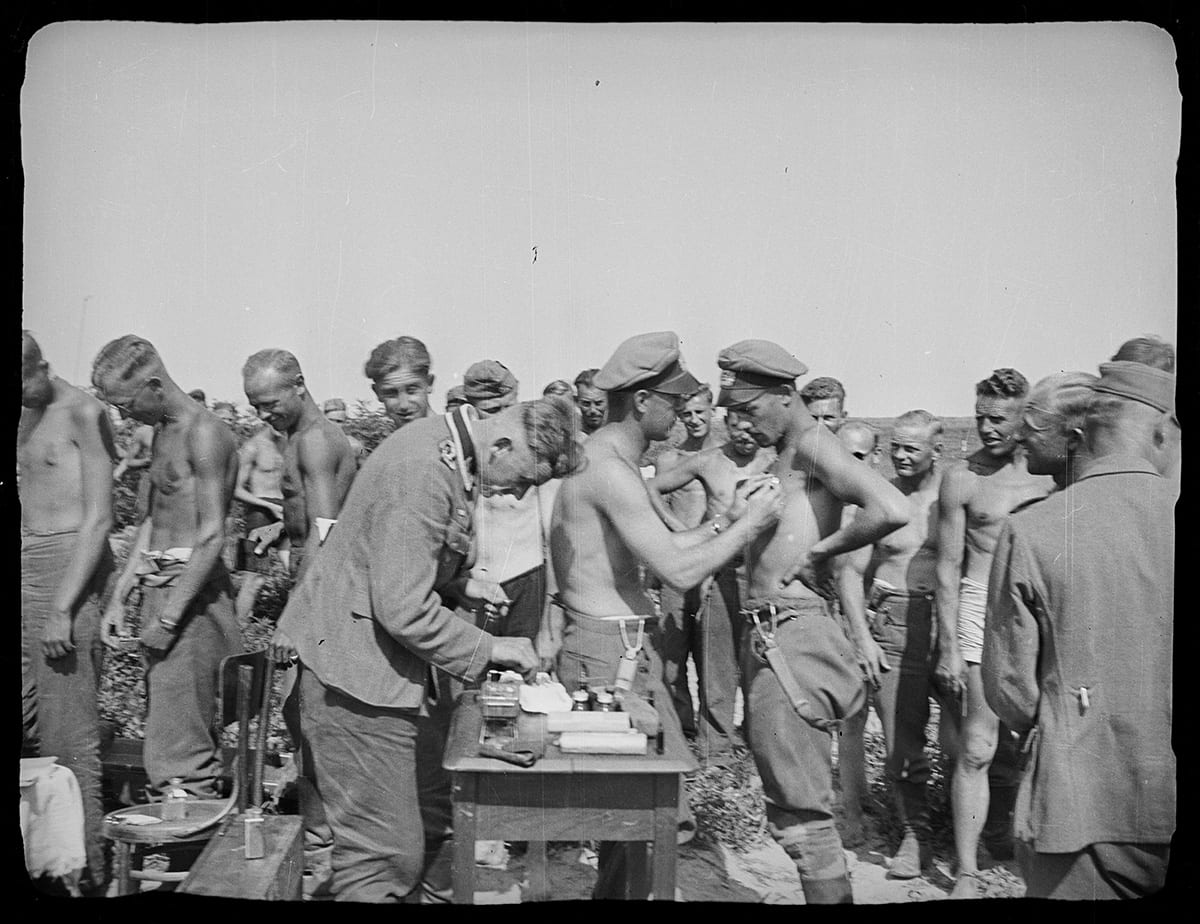
Vaccination of German soldiers. Ukraine. August - September 1941
Vaccination of German soldiers. Ukraine. August - September 1941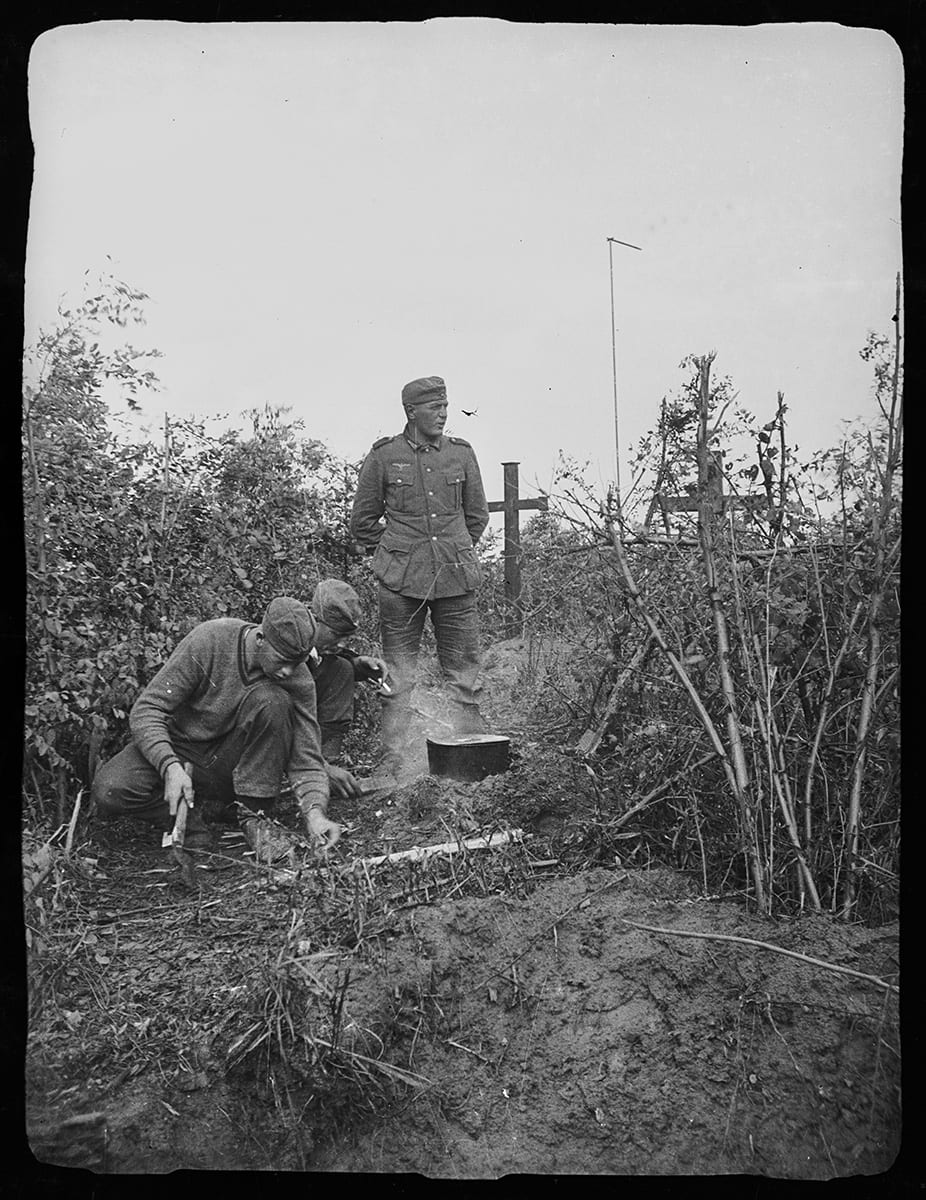
German soldiers are preparing lunch. The antenna of the radio station and the crosses of the cemetery can be seen behind. Ukraine. August - September 1941
German soldiers are preparing lunch. The antenna of the radio station and the crosses of the cemetery can be seen behind. Ukraine. August - September 1941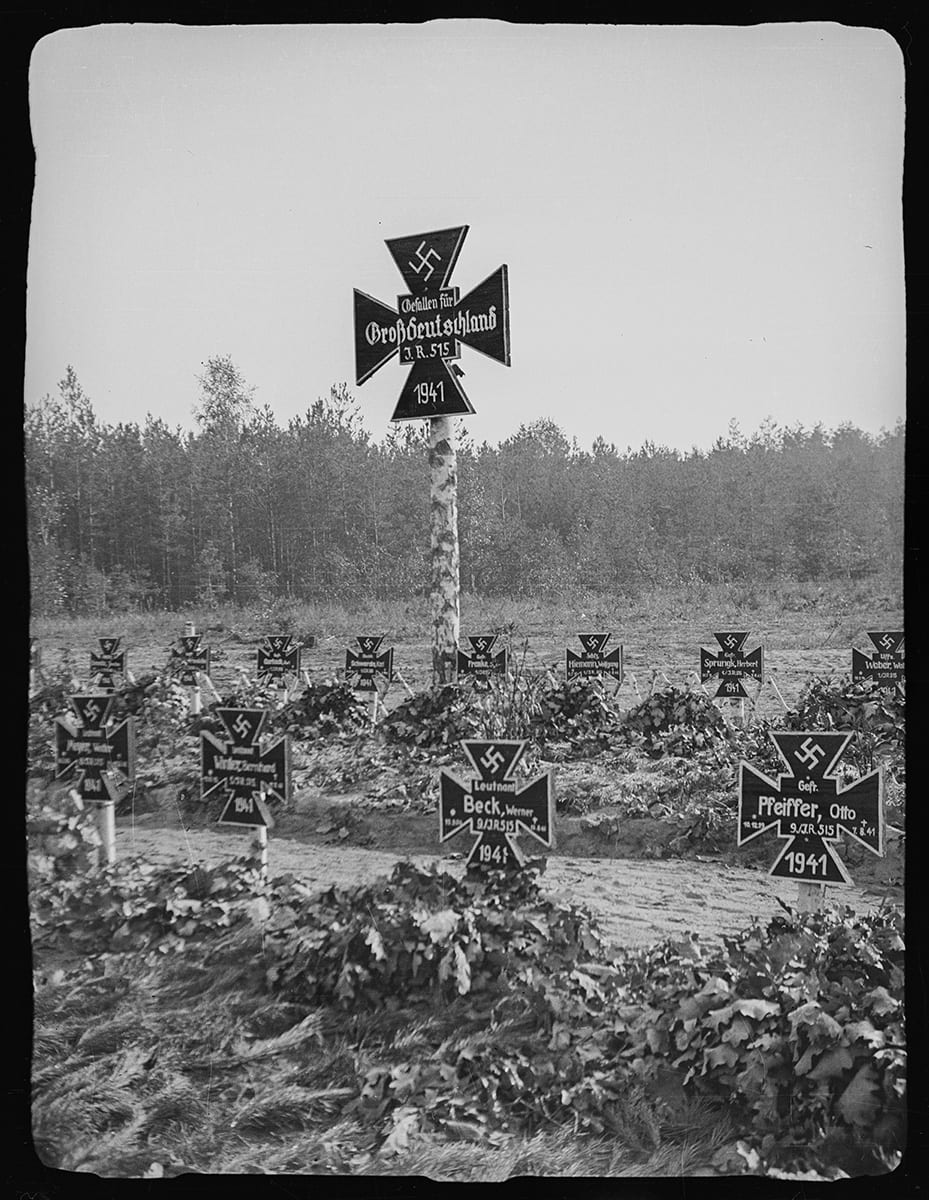
German military cemetery. All graves are dated August 7, 1941. The central cross bears the inscription "Fallen for the Great Germany. 515 jäger regiment. 1941" (нем. Gefallen für Großdeutschland. Jäger Regiment 515. 1941). Ukraine. August, 1941
German military cemetery. All graves are dated August 7, 1941. The central cross bears the inscription "Fallen for the Great Germany. 515 jäger regiment. 1941" (нем. Gefallen für Großdeutschland. Jäger Regiment 515. 1941). Ukraine. August, 1941